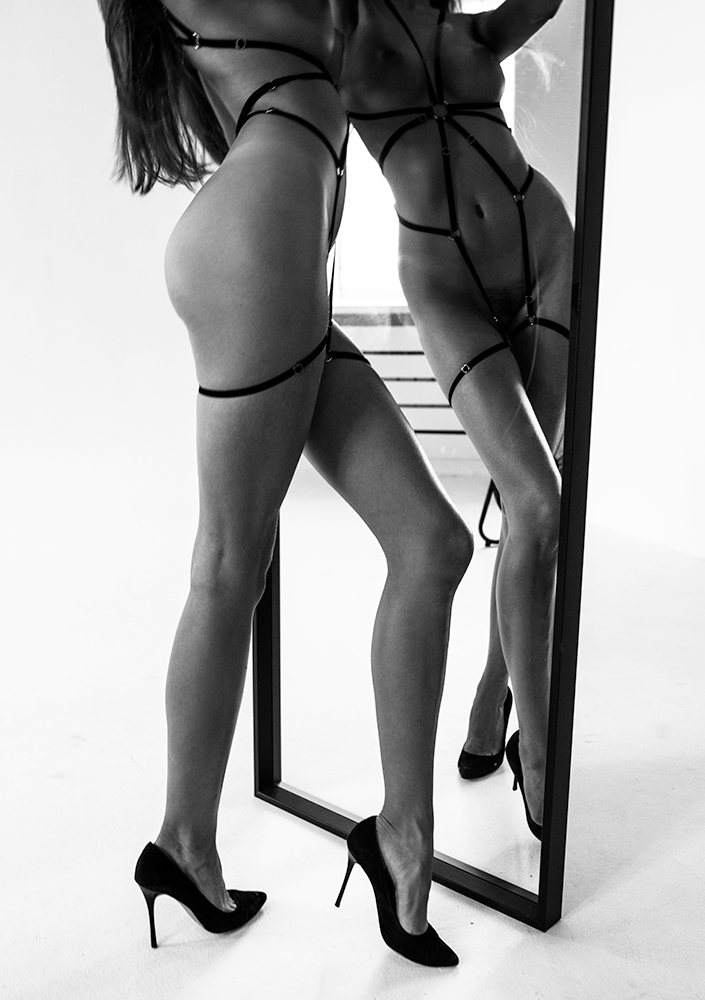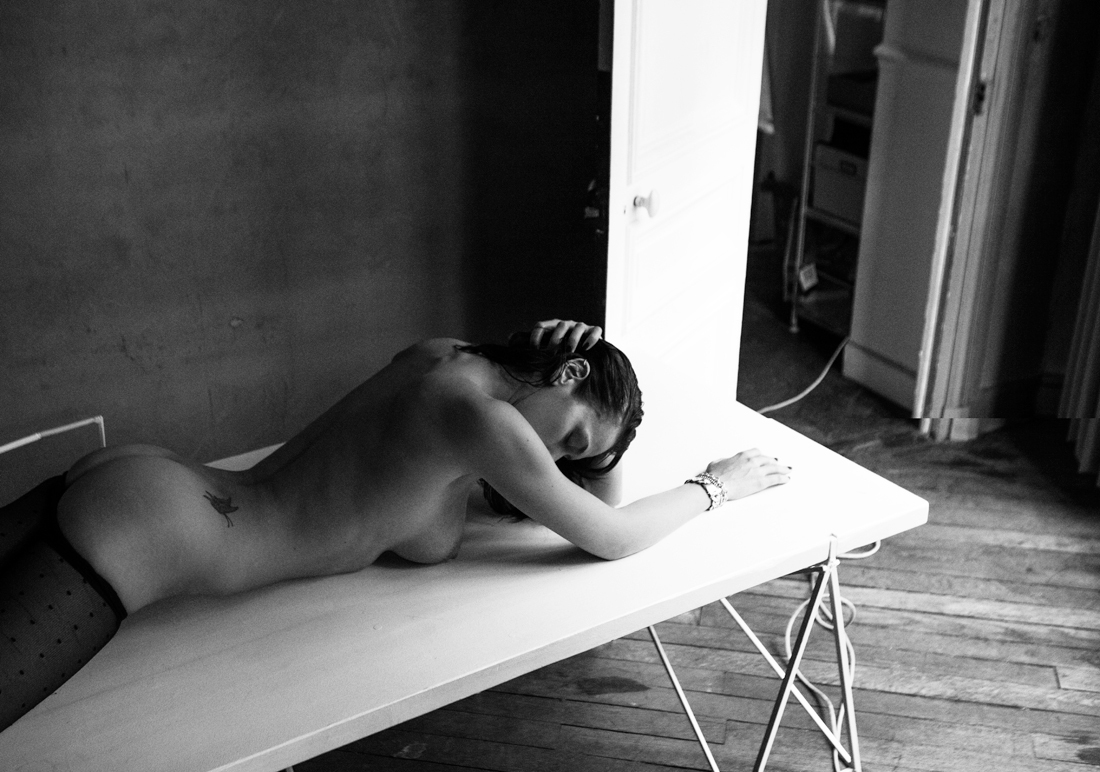on photography
- indoor vs. outdoorhow to efficiently observe and utilize the space on a set
airbnb & hotels & apartments
lofts & studios & locations - teambuilding dream teams
engaging with the team and model, instead of just working with them
what makes a great model
choose right music for your shootings - types of lightning and how to use them
equipmentlearning from masters
natural vs. strobes vs. continuous vs. led lights
my equipment - case studiesbreaking down in details what techniques and methods
I used to create my photographs. - the specifics of erotic photographyeros
first experiments
erotic portraits
maintaining aesthetics
indoor vs. outdoor
airbnb & hotels & apartments
lofts & studios & locations

how do you choose locations for your shootings?
where do you feel more creative and productive? studio or outdoor?
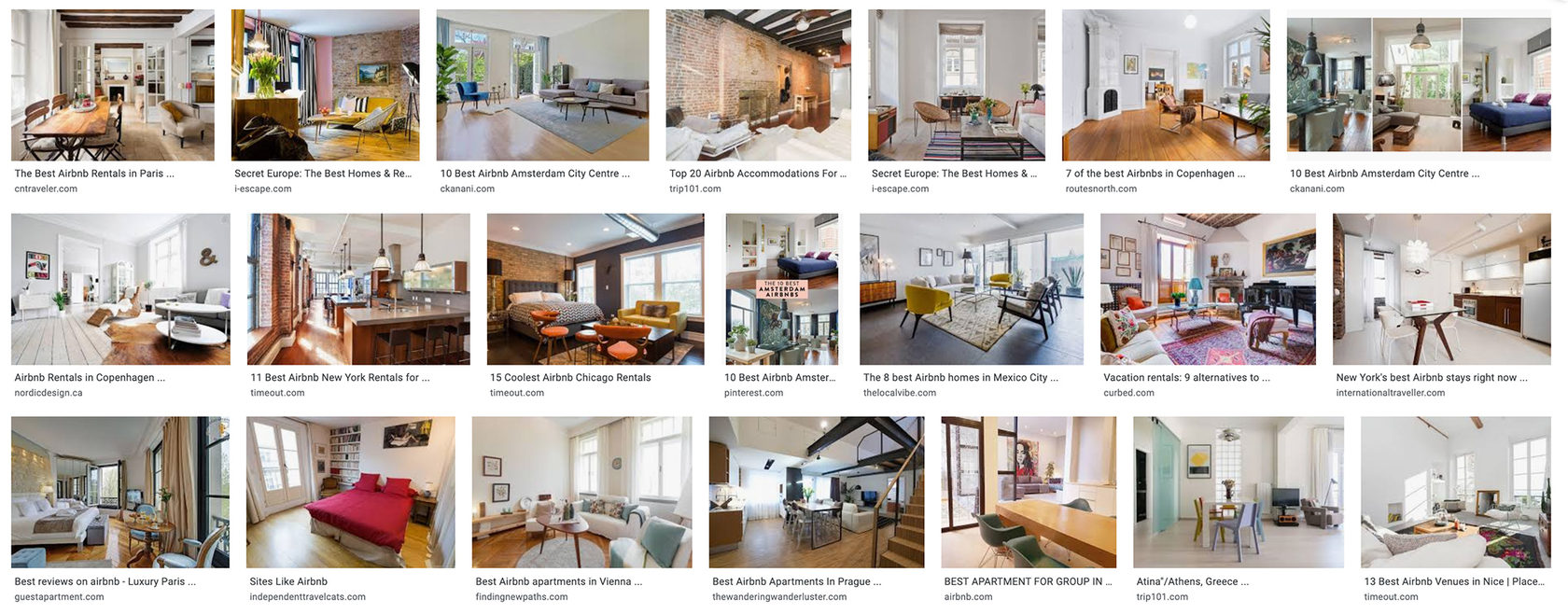
But bigger productions? That’s another story. Most owners won’t let you bring in a whole crew, lights, racks of clothes. If you ask for permission, nine times out of ten the answer is no. So it works best for lean setups — just you, a model, maybe one assistant.
It’s also cheaper than booking a proper studio, but you have to watch the details. Check-in times can kill a shoot. If the key isn’t available until 3pm, that’s half the day gone. And always, always double-check that the apartment actually looks like the photos online. I’ve shown up to places that felt like a totally different reality from the listing.
Airbnb is a gamble. Sometimes you hit the jackpot with a space that feels cinematic. Sometimes you’re stuck making magic in a room that’s way smaller and darker than advertised.







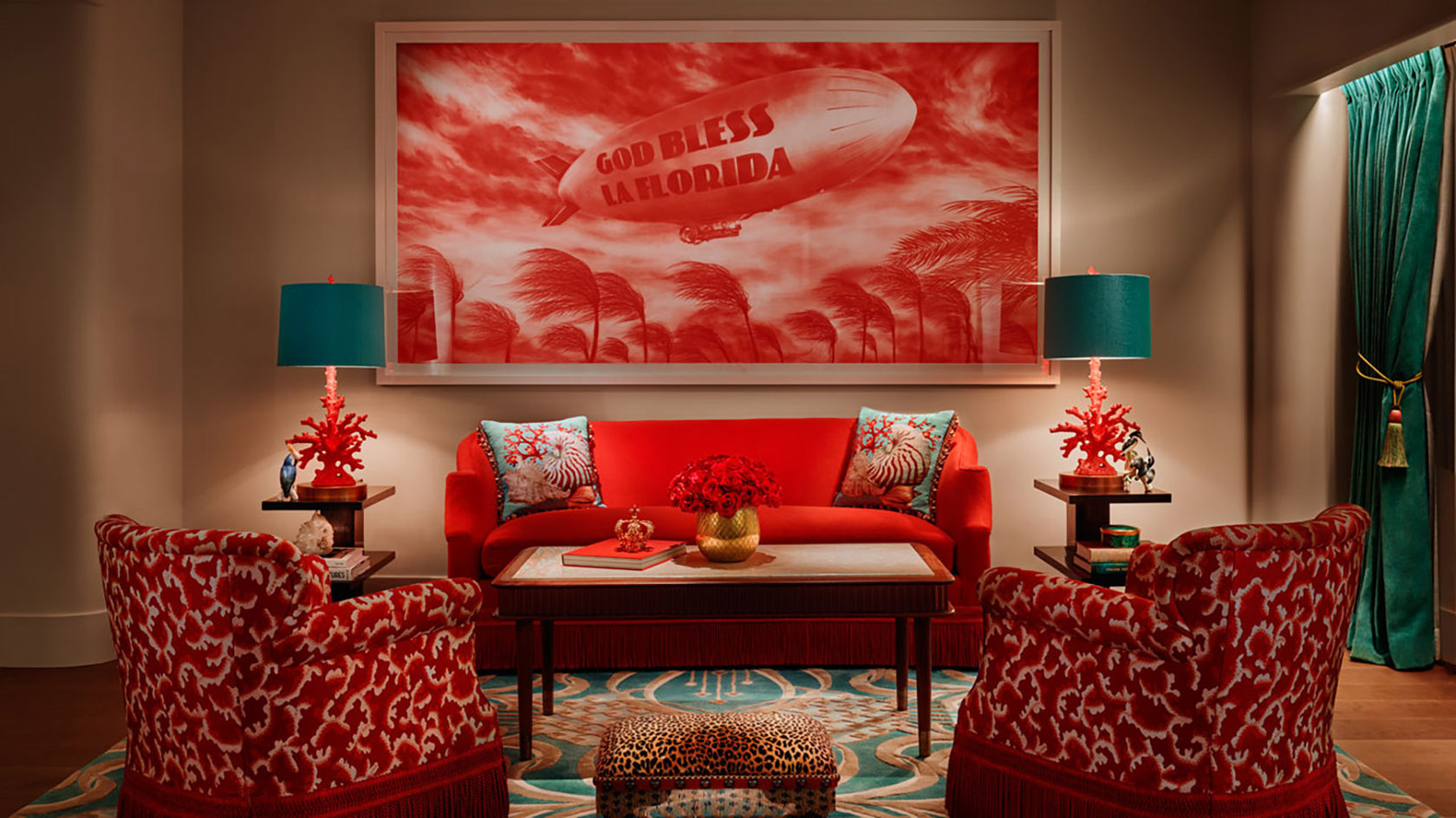
When I work with private clients, I almost always push for a boutique hotel. It feels intimate, less intimidating. Non-professionals open up way faster in a hotel bed than against white studio walls. There’s something about the privacy of the space — the way the room feels like it belongs to them for the day — that makes posing natural.
Of course, there are limits. If you show up with a full crew, racks of clothes, assistants running around, hotels start to push back. Some ban shooting altogether, others ask insane fees. And even when you get in, you can’t ignore the basics: hotel rooms can be dark, cramped, or just plain ugly. You have to work with what’s there, find the angles, bend the light.
But when it clicks? A single room becomes a world.






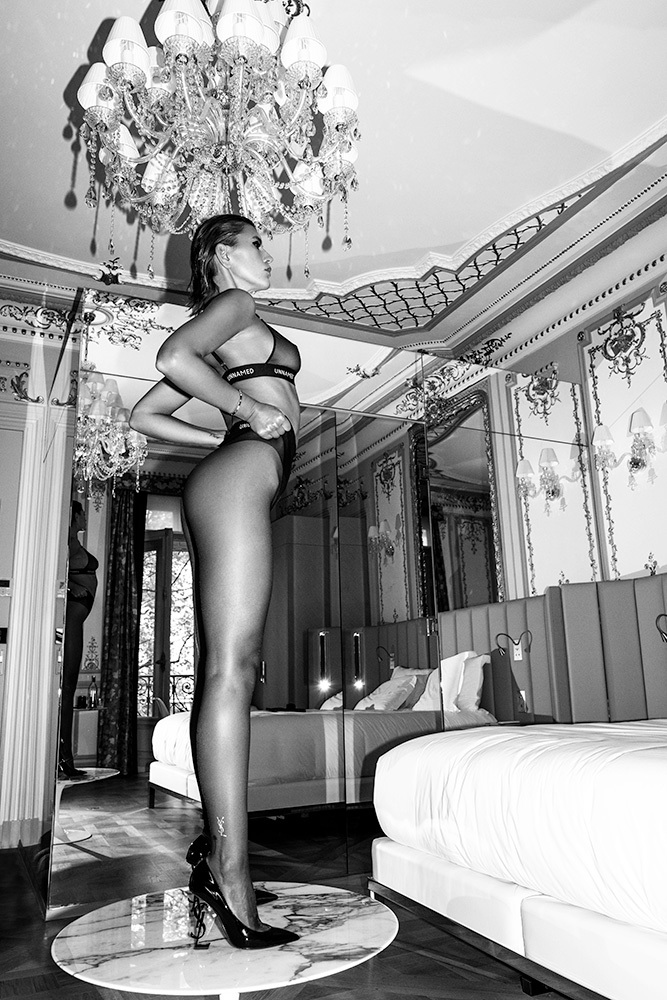



paris 2019
In Paris, I started calling boutique hotels, pitching the idea. Many of them agree to trade a room for promotion in the magazine — free exposure that can bring them new clients. One of them said yes: Les Bains.
If you don’t know it, look it up. It’s not just a hotel. It’s history. Once a 19th-century bathhouse, later redesigned by Philippe Starck, Les Bains was the heartbeat of Paris nightlife in the late ’70s and ’80s. Joy Division recorded in the basement. Prince showed up for surprise sets. Depeche Mode played there long before stadium tours. Even David Guetta started as their house DJ.
And now, here we were, shooting Vika as La Femme Fatale in those same rooms. The mix of fashion and that history gave the shoot an extra pulse. You could feel it in the air, like we were borrowing ghosts for the day.
I’ll be posting the photos on my Instagram in the next few days. The first one is already up — Vika as La Femme Fatale. It’s also available as a poster.
Source
It provided us with additional inspiration for the shoot.

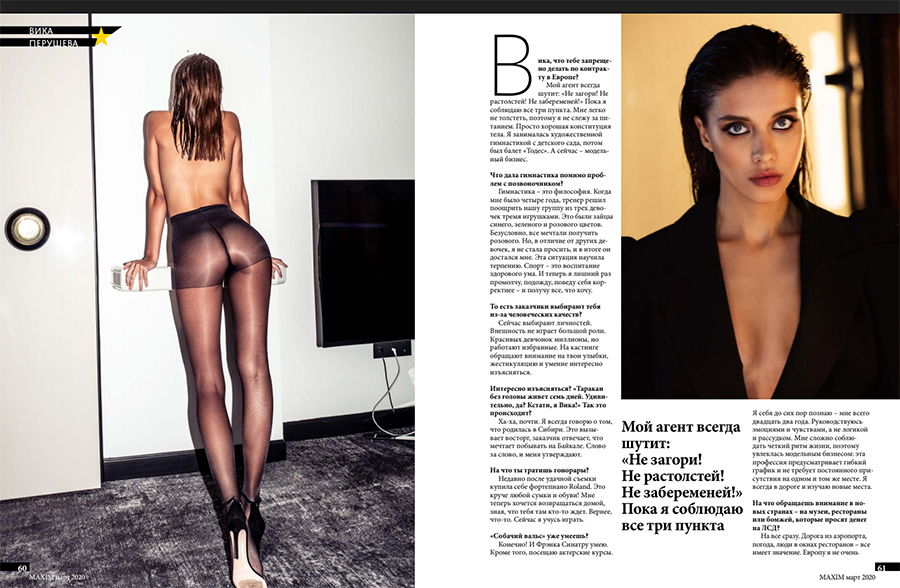
tel-aviv 2019



los-angeles 2020



los-angeles 2020






paris 2020






monaco 2020



berlin 2020
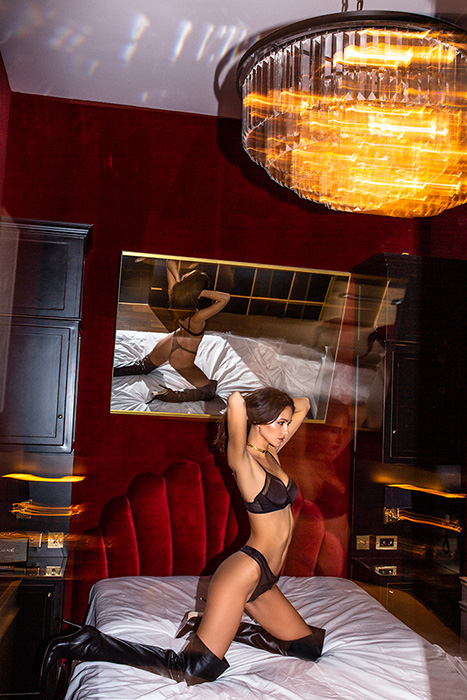
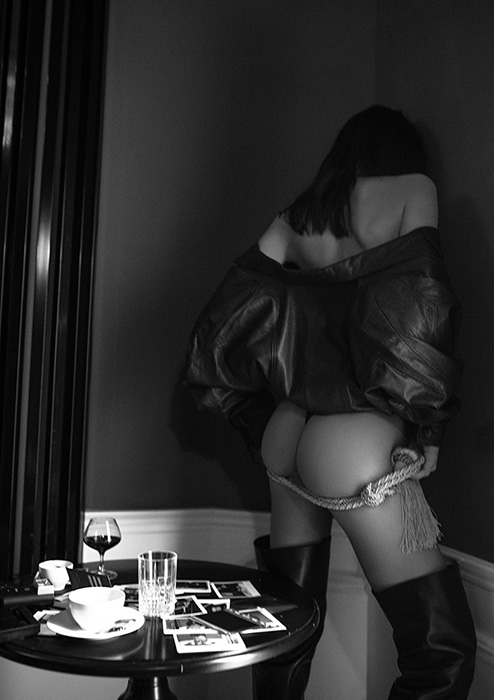
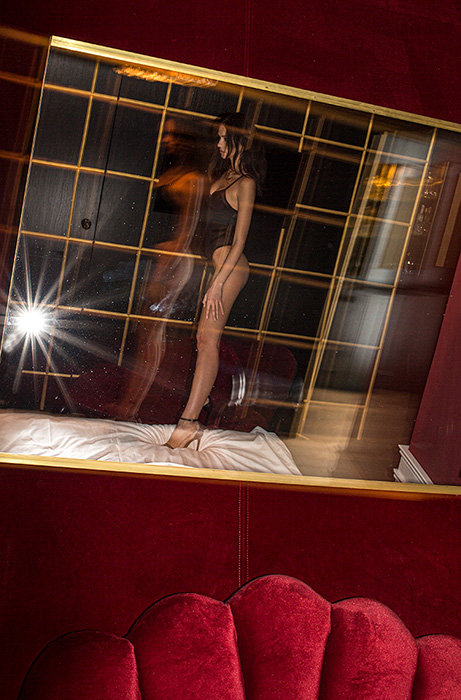



kyiv 2020










" It's that I don't like white paper backgrounds. A woman does not live in front of white paper. She lives on the street, in a motor car, in a hotel room.
I have always avoided photographing in the studio. A woman does not spend her life sitting or standing in front of a seamless white paper background. Although it makes my life more complicated, I prefer to take my camera out into the street... and places that are out of bounds for photographers have always had a special attraction for me."
― Helmut Newton

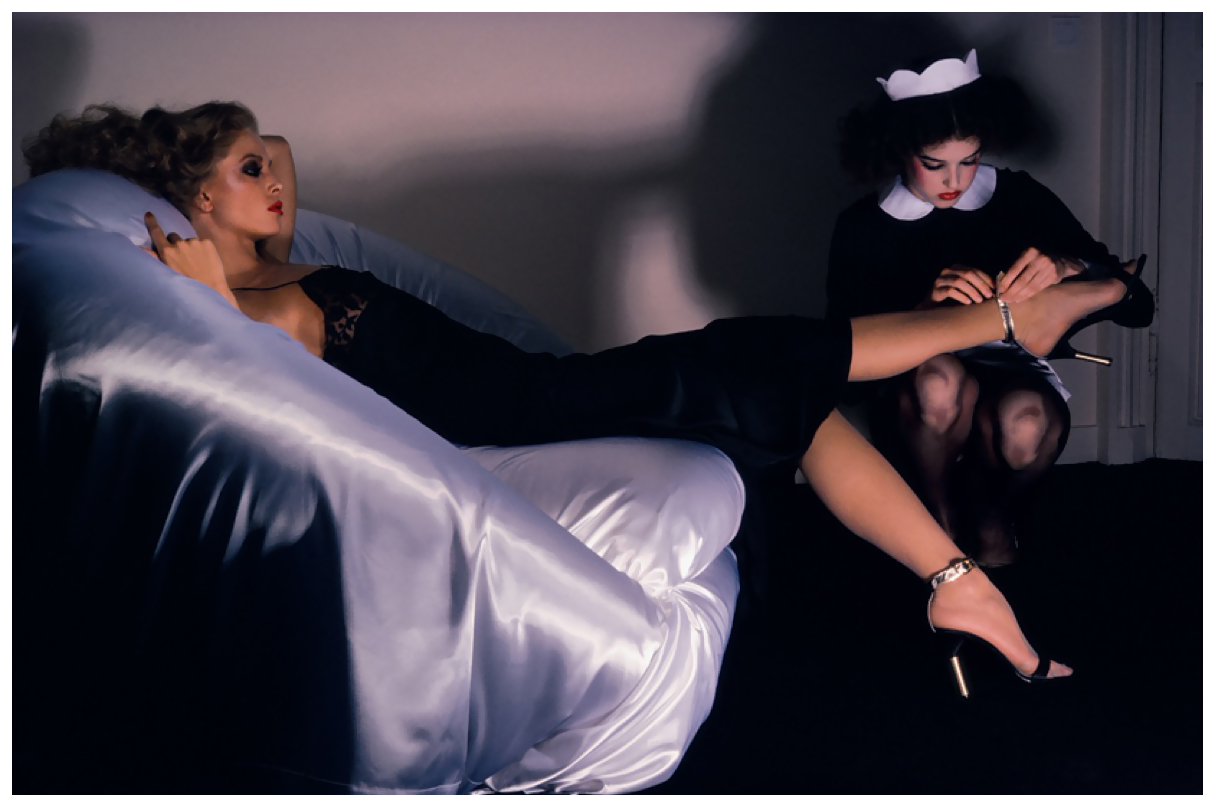


Four Rooms, Allison Anders / Alexandre Rockwell / Robert Rodriguez / Quentin Tarantino, 1995
Mystery Train, Jim Jarmusch, 1989
The Shining, Stanley Kubrick, 1980
Barton Fink, Joel Coen / Ethan Coen, 1991
Youth, Paolo Sorrentino, 2015
Psycho, Alfred Hitchcock, 1960
The Grand Budapest Hotel, Wes Anderson, 2014
Lost in Translation, Sofia Coppola, 2003
Death in Venice, Luchino Visconti, 1971
Chelsea Girls, Andy Warhol, 1966
The Night Porter, Liliana Cavani, 1974


Link
FRIEND'S PLACES
With time my friend's cycle grows and I often would ask my friend if I can shoot at their places. Of course if their place is good enough to take great images which is not always the case.
Since I travel frequently, I am often in unfamiliar cities and have to start from scratch when searching for new locations for my photo shoots, which can be a challenge as I need to establish myself first. Over time, I have built up a network of friends, and I sometimes ask them if I can use their places for shoots, but it's not always possible as their places may not be suitable for capturing great images. Additionally, I've never been charged by my friends for the use of their spaces.
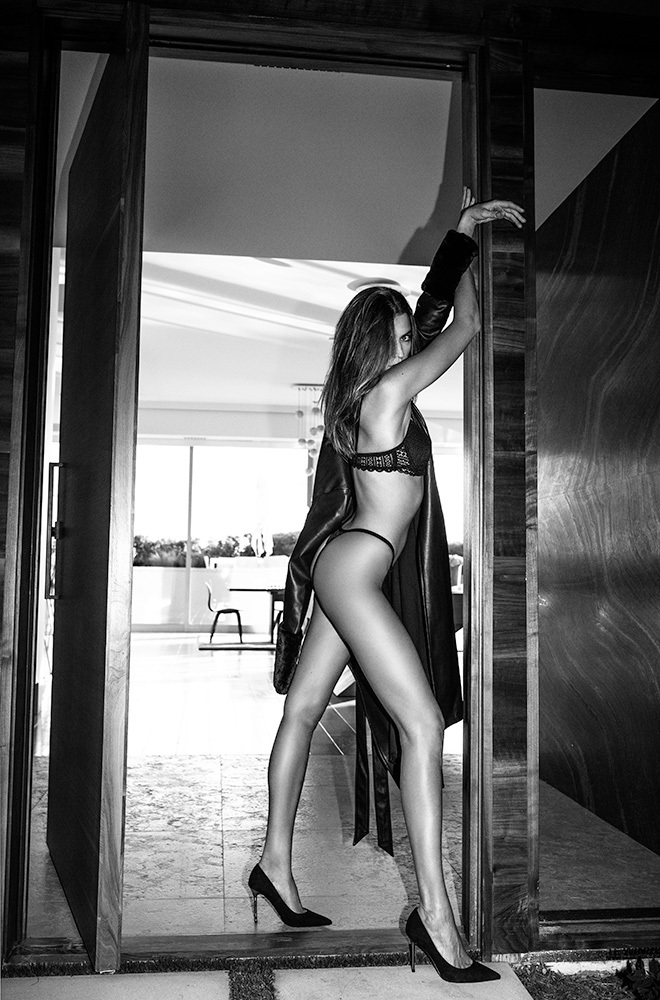


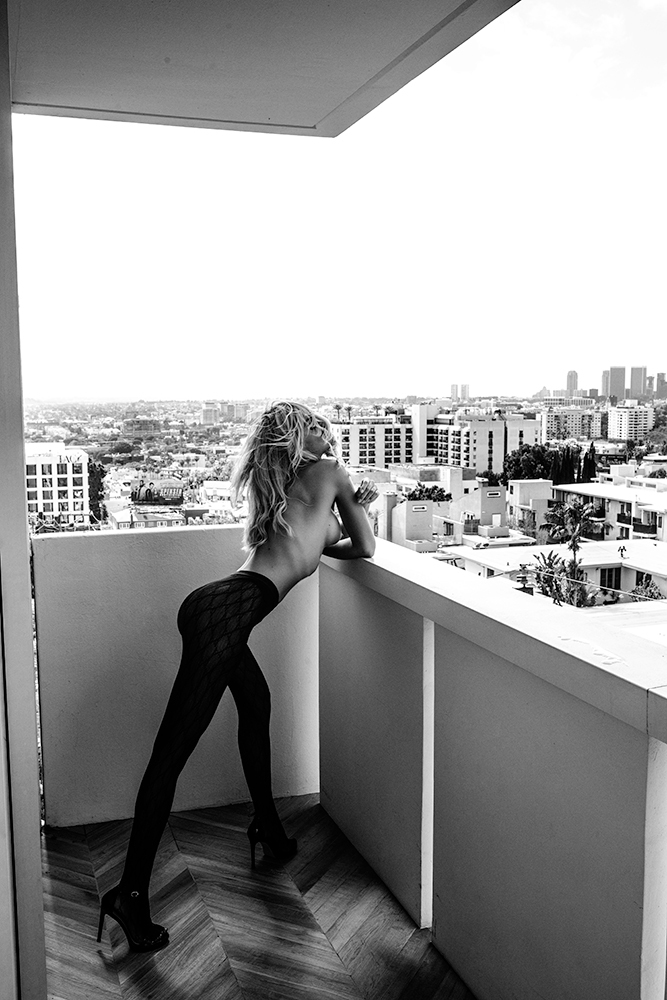


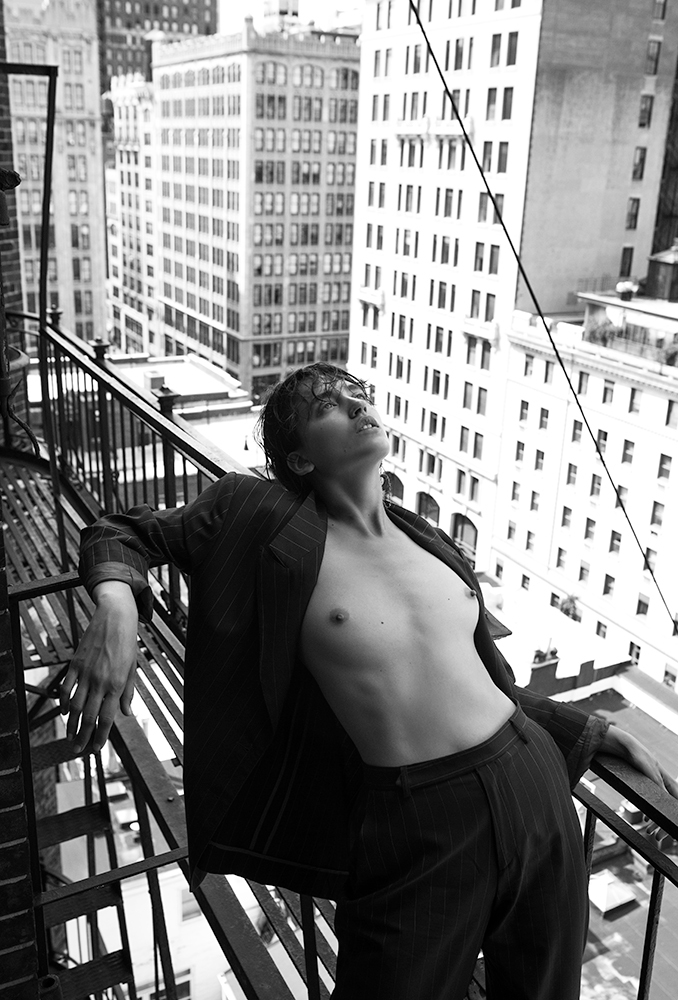





" Photography is 10% inspiration and 90% moving furniture. "
― Helmut Newton
I analyze and scan the space for the presence of elements that are interesting for use in the frame: different options for camera angles, the ratio of light-shadow. I think about where and how I would put the equipment, what poses that model could take and how it might affect the composition.
Thanks to these theoretical exercises I get prepared for my future shootings. It helps me to develop and maintain a skill to notice and seize potential for good images around me.
Main goal is to develop and maintain a prized skill - observation.

Where would you put the model? Which corner has the best light? What kind of mood does the place give you — raw, elegant, cinematic, intimate?
Think about the poses. Does the space call for someone leaning, stretched out, curled up, moving? Imagine how their body would fit into the geometry of the room.
Then add light in your head. If you had one strobe — where would you place it? If only natural light, how would you use it? Is there a window that could give you a perfect silhouette?
Do this over and over. Train your imagination like a muscle. The more you practice, the faster your brain starts composing pictures out of thin air. Suddenly, you’re not just seeing a café, or a stairwell, or a hotel bed — you’re seeing a shot.
That’s how you sharpen your compositional instincts. Before you even touch a camera.
PHOTO STUDIO

Learning to use artificial lighting, whether strobe or continuous, can produce a variety of effects that are difficult or impossible to achieve with natural light outside. You have the freedom to experiment with many different lighting modifiers and develop your unique style over time.
Shooting in well-established and trendy studios can give potential clients a positive impression of your work. You don't have to worry about the changing weather, and most studios include equipment in their rental price. Shooting in a studio can also help you stay focused and less distracted.
However, relying solely on studio shooting can make you complacent, leading to predictable and uninteresting results if you always use the same lighting setups.





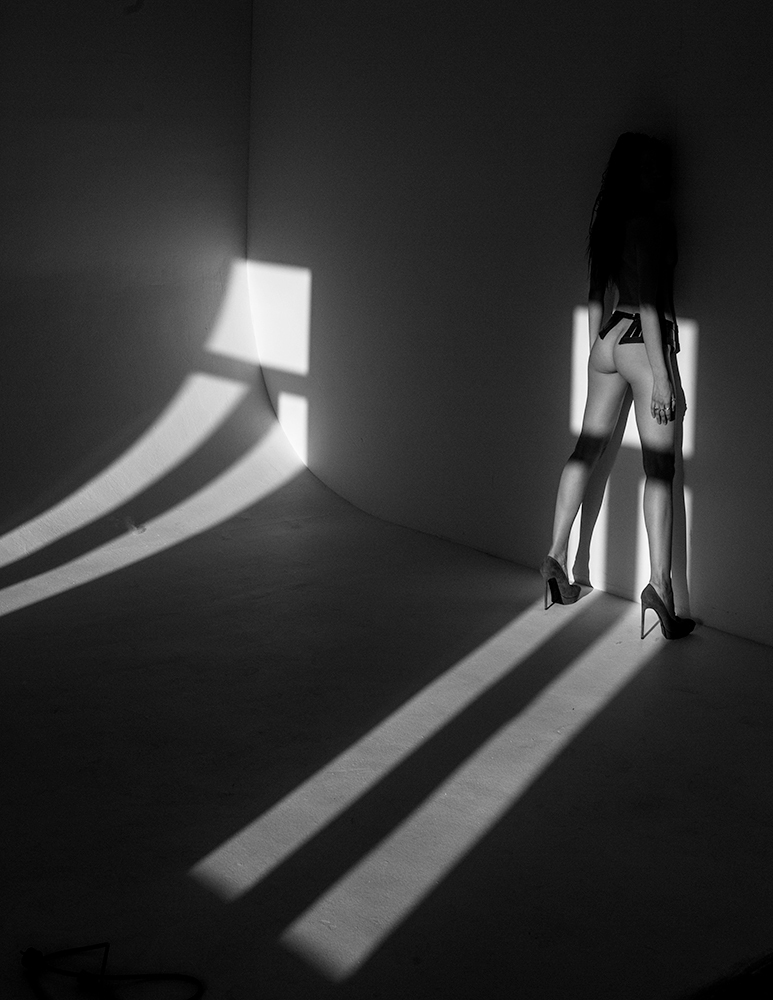
It might sound obsessive, but nothing kills the energy of a shoot faster than realizing you’re missing something stupid — like a card reader, or the only battery that still had power. I’ve learned the hard way.
I also invested in a solid suitcase for my equipment. Best decision ever. Everything has its place, nothing rattling around, and I don’t waste time digging through random bags. It’s less physical strain too. That way, I save my energy for where it matters — the shoot, the people, the moments.
Because when you walk into a set, you want to be free. Not distracted, not stressed. Just ready.
" I always prefer to work in the studio. It isolates people from their environment.
They become in a sense . . . symbolic of themselves. I often feel that people come to me to be photographed as they would go to a doctor or a fortune teller - to find out how they are. "
― Richard Avedon
It changes the energy. Suddenly the model isn’t just posing, she’s interacting with the space. The tripod can become a line in the composition, the strobe a piece of architecture, the cables something to lean into. It opens up more options for poses, for tension, for intensity.
I’ve never been interested in hiding the tools of photography. I’d rather let them live inside the image, make them part of the atmosphere. The result is raw, cinematic, and more alive than a perfectly polished backdrop.
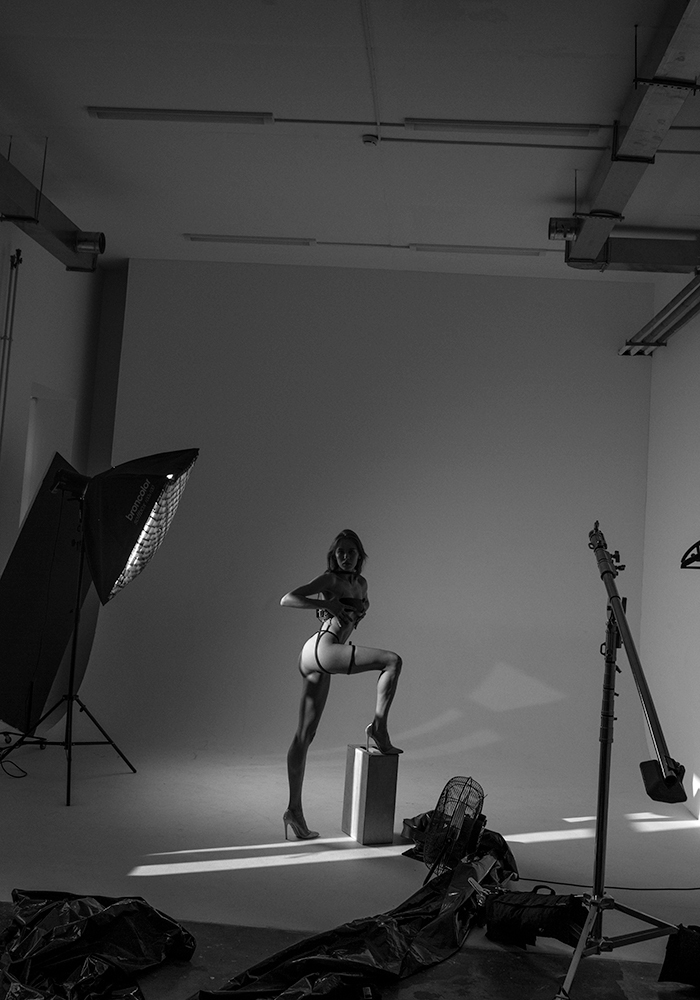


" I show elements of the set in my pictures because it's not real. When I see movies, I often love the 'making of' more than the movie itself. It's not so final. When you have a woman just standing there, it doesn't mean much. "
― Peter Lindbergh
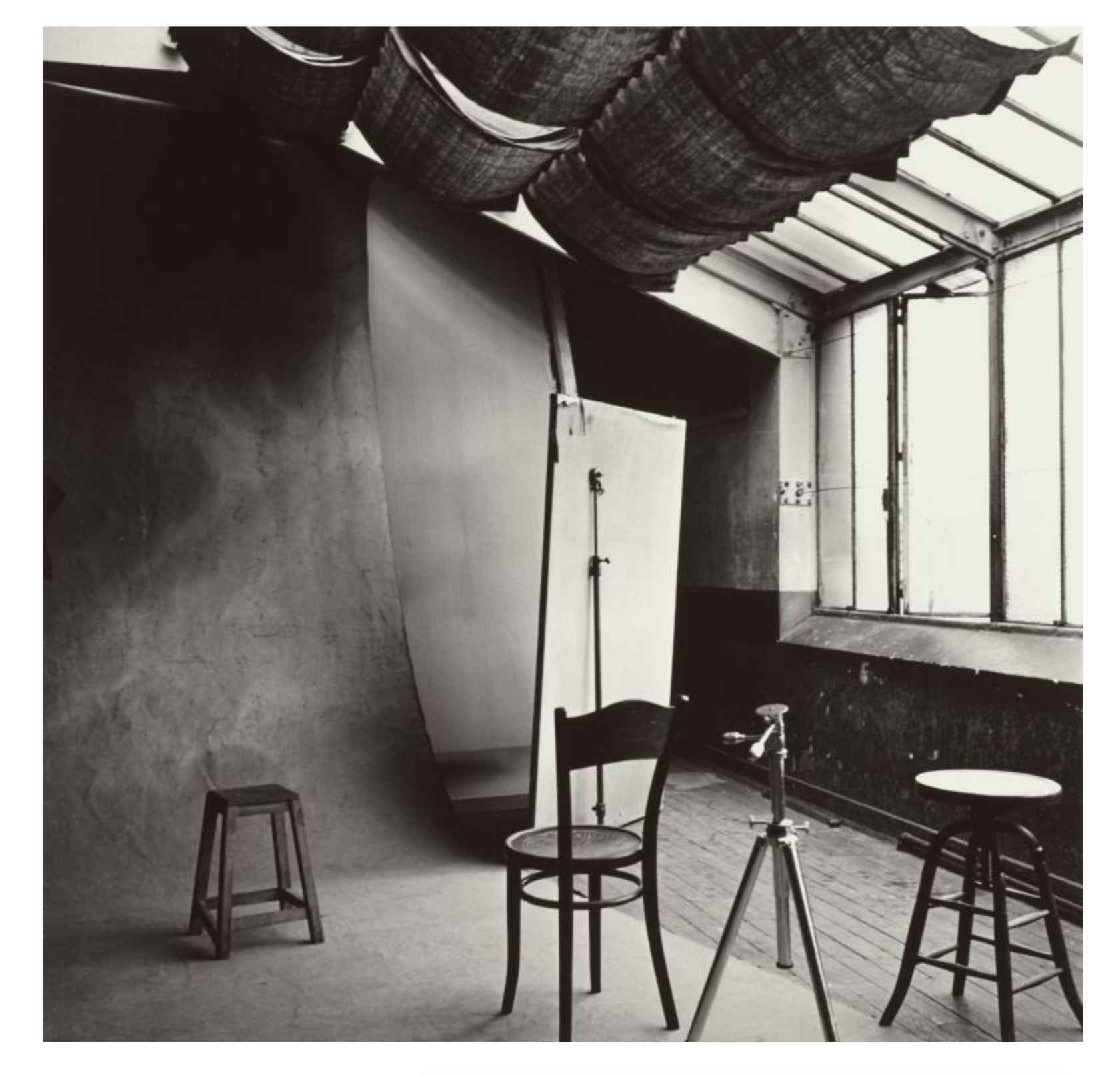
paris
What always strikes me is how many iconic images came out of tiny, almost unimpressive rooms. Four walls, a light, and a subject — that’s it. No glossy setup, no cathedral-sized space. Just vision. It’s a good reminder that it’s not the square meters that count, it’s what you can do with them.
Some of my favorite shoots happened in spaces that felt too small, too simple. And maybe that’s the point — limitations force you to be sharper, hungrier, more inventive. The room doesn’t make the photograph. You do.
Look at their studios. Search for behind-the-scenes shots, documentaries, interviews, or even just glimpses on Instagram. Pay attention not only to the equipment, but to the space itself — the walls, the chaos (or lack of it), the way they arrange light stands, the energy of the room.
Notice the atmosphere. Ask yourself: does the studio feel experimental, polished, raw, controlled? What does that tell you about how they work and think?
Compare with your own. What would your studio look like in a photo? What story would it tell about you as an artist?
Take notes. Write down three things you’d borrow from each studio — it could be as small as how they pin references to a wall, or as big as how they use natural light from a window.
Optional challenge: Photograph your own studio as if it were someone else’s. Show it as a portrait of how you work.

paris

berlin
It felt intimate, almost voyeuristic. Like I was trespassing in his private world, but invited at the same time. To see what he wore, what he read, how he surrounded himself — it gave me a different kind of understanding of him, beyond the images. Suddenly, Helmut wasn’t just the myth, the name, the legend. He was a man, with habits and tastes, with rituals and tools that shaped his work.
That hit me. Because sometimes you forget that behind every iconic photograph, there’s a desk, a jacket, a book, a pair of glasses. The ordinary objects that carried the weight of the extraordinary.

OUTDOOR



I absolutely adore shooting outside, but it can also be quite a challenge as it always feels like an adventure! Despite how much I prepare, almost every shoot turns out to be unpredictable. The weather may suddenly change, tourists may appear right as I'm about to snap a shot, or my camera battery may die and I'll need to find a way to charge it.
Yet, the allure of the street lies in its authentic portrayal of real life, making it so exhilarating to capture moments and create images that are impossible to recreate in a studio. My photography has always been about challenging myself and shooting outside was a way to do just that. I take what I'm given, but I arrange the world according to my own vision, and it can be a tough feat.
Eventually, I came to realize that the studio environment wasn't conducive to my creative process. My imagination required the realism of outdoor locations or even hotels to truly thrive.



The pros? Endless. The backgrounds change with every corner you turn — a peeling wall, a neon sign, an empty parking lot. Every location tells its own story, and you can ride that mood. Natural light, when it hits right, is magic — it wraps around the body in ways no softbox ever could. Out there, you get spontaneity, the energy of real life, the chance to weave in the culture and texture of the streets. And sometimes it’s cheaper, too. No studio rent, no sterile walls — just the city breathing life into your shoot. The team feels it as well: the buzz of being on location, the sense that anything could happen. Even the candid moments you catch between poses often end up stronger than the staged ones.
But the cons are just as real. The weather doesn’t care about your mood board. One minute it’s perfect, the next it’s pouring, and suddenly your vision drowns. Light shifts every few minutes, so you’re constantly chasing it. Then there’s the noise — sirens, curious strangers, kids kicking a ball right into your frame. And the paperwork: some places demand permits that eat up time and budget. Power outlets? Forget it. Half the time you’re praying your batteries last. And depending on where you are, you’ve also got to think about safety — traffic, rough terrain, or just the unpredictability of being in a public space. Even wardrobe can betray you; what looks stunning in a studio can fall apart in the wind, rain, or cold.
- Still — for me, the pros almost always win. Shooting outdoors is a gamble, yes, but it’s a gamble that gives you pictures no studio could ever replicate.
It’s funny, but it’s also genius. He wasn’t talking about laziness — he was talking about efficiency. About trusting your eye to see possibilities right where you are, instead of chasing some mythical “perfect” location miles away.
I’ve taken this to heart. When I walk outside, I train myself to notice things: the way the light hits a wall at 5pm, a staircase that feels cinematic, a corner café with mirrors and shadows. I take quick notes, snap reference photos, sometimes even sketch an idea if something sparks. Later, I catalog everything — folders, mood boards, scraps that eventually evolve into treatments.
The beauty of this practice is that when the time comes for a shoot, I don’t waste energy scrambling for locations. I already have a bank of places I know work. Even better, these locations carry my personal history — I’ve walked by them, I’ve seen them in different weather, I’ve felt their atmosphere.
It’s not about traveling the world to find beauty. Often, the strongest images are waiting within your daily three-mile radius.

Whenever something catches my eye, I pull out my phone, take a quick photo, and mark the exact spot on a map. Over time, this becomes a personal catalog of ready-to-use locations.
But it’s not only about how it looks. I also check the practical details:
- How crowded does it get at different times of the day?
- Is there a discreet corner for the model to change?
- Can I find a power source if I need extra lights?
- What direction does the natural light come from, and how does it shift throughout the day?
Later, when I’m planning a shoot, I revisit these notes and start imagining poses for the models, how to place the lighting, and how the architecture or textures of the space can interact with the body.
This way, I’m never starting from zero. I already have a bank of locations — both visually inspiring and logistically sound — that I can drop into a treatment whenever the right project comes along.

forms & shapes
color & forms
Next, switch your focus to shapes. Hunt for circles, squares, ovals, rhombuses — anything with a clear geometry. Notice how these forms structure space and guide your perception.
Finally, combine both layers. Search for color–shape pairings: red squares, green triangles, blue rhombuses. Observe how these combinations stand out, how they interact, and what kind of associations they trigger.
This exercise sharpens your vision and helps you filter complex environments into usable creative elements. Over time, it makes it easier to quickly identify and highlight specific objects and patterns within a larger context. As a fashion photographer, this skill becomes even more powerful when paired with a solid understanding of color theory, since different hues and combinations can dramatically influence mood, perception, and the story your images tell.
moscow






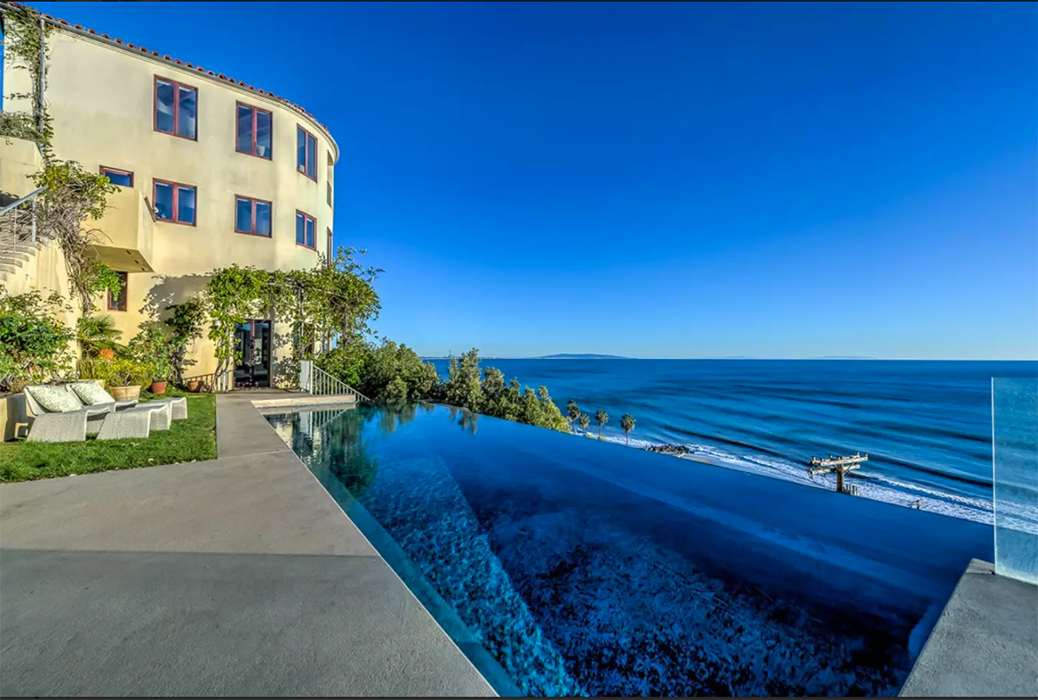










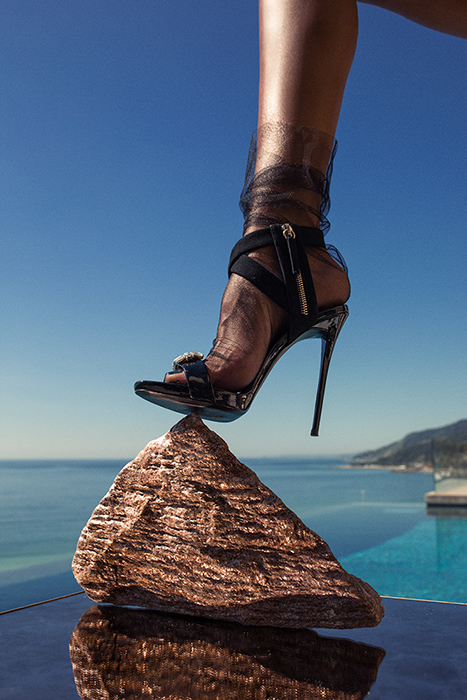

Take risks. Stay curious. Try everything. With time and experience, confidence will come.
Often, the things you think you don’t want to do can reveal what you actually do want — every step teaches you something.
The key is clarity. The clearer you are about your goals, the faster you’ll move forward.
teams
engaging with the team and model, instead of just working with them
what makes a great model
choose right music for your shootings
" If I create anything I create an atmosphere of trust an opennes. "
― Sante D'Orazio

" Maybe people have no idea how much work is behind a picture. It can seem very effortless, but there is a lot of work. It's exactly like doing ballet. It's hours and hours, but when you go onstage, it's just the pleasure of dancing."
― Carine Roitfeld
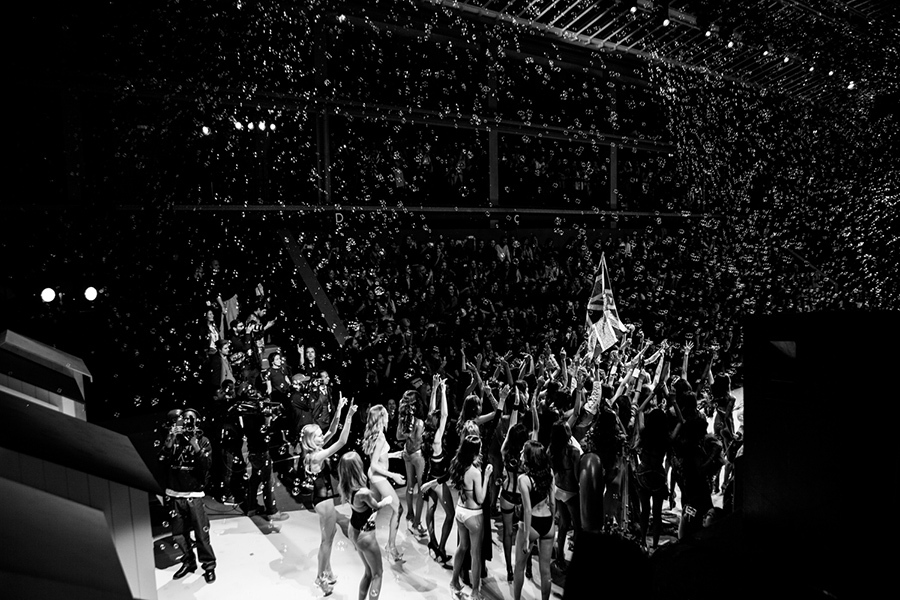
Trying to control every detail only kills the magic. As James Arthur Ray said: “Control is never achieved when sought after directly. It is the surprising consequence of letting go.” The best shoots happen when you loosen your grip, stay open, and trust the talent around you. You’re working with professionals — lean on them, exchange ideas, let their skills push your vision further.
A relaxed, productive environment starts with you. Conviction and clear communication set the tone. It’s not just about you and the model feeling at ease — it’s the whole crew. Guide them, involve them, and don’t be afraid to let accidents or surprises shift the direction. Some of the best images happen when life sneaks into the frame.
Collaboration doesn’t weaken your vision — it sharpens it. Invite ideas, empower your team, and turn the shoot into a creative conversation rather than a one-way order.
And when things go wrong — because they always do — treat setbacks as part of the process. Use them to get better at handling pressure, at working with people, at checking whether your choices are really aligned with your intention.
One last detail: when reviewing shots in front of the model, do it with care. Be discreet. A little respect goes a long way.

" If you want to become the best, work with the best. Best investment that will pay off.
Work with people that really want to work with you. "
― Unknown
Look for new connections and create opportunities.



Current Network – Create a list of all the artists, stylists, makeup artists, models, designers, and other collaborators you’re already working with. Include their contact details, links to portfolios, and notes on what projects you’ve done together.
Future Aspirations – Make a separate list of the artists, models, magazines, and brands you want to collaborate with in the future. Be specific. Add references to why you want to work with them — their aesthetic, energy, or alignment with your vision.
This exercise is not just about organization. It’s about clarity. Knowing exactly who’s in your circle now and who you want to bring into it helps you see the bigger picture of your creative journey — and gives you a roadmap for your next steps.





Good communication is everything. The way you speak and guide the model can make or break the shoot. Be clear with your ideas, but stay respectful and open. Encourage the model to express themselves, to bring their own individuality into the frame. That spark of personality is what transforms a photograph from technically correct into emotionally charged.
When directing, be careful not to reduce models to lifeless mannequins. Poses should breathe, flow, and adapt to the energy of the moment. A shoot is not about control — it’s about collaboration.
And above all, always remember: models are human beings, not props. By creating an atmosphere of trust, respect, and professionalism, you not only capture better images but also build a reputation as someone people genuinely want to work with.
Agency Models vs. Instagram Models
Muses.
" I wish I could say the same for the young women who were just on the runways at the New York fall collections. Overall, they were pale and thin, and entirely lacking in the joyfulness and charm that once defined the supermodel. This, of course, is not their fault: Designers now near-uniformly favor a non-vivacious, homogenous ideal."
― Anna Wintour


- "The September Issue" (2009) - This documentary follows the making of the September 2007 issue of Vogue magazine, which featured supermodel Sienna Miller on the cover.
- "Catwalk" (1996) - Directed by Robert Leacock, this documentary follows the careers of supermodels Christy Turlington, Naomi Campbell, and Cindy Crawford during the height of the supermodel era in the 1990s.
- "Unzipped" (1995) - This documentary follows designer Isaac Mizrahi as he prepares his Fall 1994 collection, which featured appearances by supermodels like Naomi Campbell and Cindy Crawford.
- "In Vogue: The Editor's Eye" (2012) - This documentary explores the work of Vogue magazine's legendary fashion editors, including Grace Coddington, who was a model before becoming a stylist.
- "The Model Agency" (2011) - This British documentary series follows the daily operations of Premier Model Management, a top modeling agency that has represented supermodels like Naomi Campbell, Claudia Schiffer, and Cindy Crawford.
- "About Face: Supermodels Then and Now" (2012) - This documentary explores the lives and careers of some of the most famous supermodels of the 1980s and 1990s, including Christie Brinkley, Carol Alt, and Isabella Rossellini.
- "The Rise and Fall of the Supermodel" (2012) - This documentary takes a critical look at the supermodel phenomenon of the 1990s and its impact on the fashion industry.
- "Naomi Campbell: The Face" (2013) - This reality TV series follows supermodel Naomi Campbell as she mentors and coaches a group of aspiring models competing for a contract with her modeling agency.
- "The Model Life" (1995) - This documentary series follows a group of aspiring models as they navigate the competitive and often cutthroat world of modeling in the 1990s.


Veruschka von Lehndorff, commonly known as Veruschka, is a German model and actress. She was born on May 14, 1939, in East Prussia, Germany (now Poland). Veruschka is considered to be one of the world's first supermodels, and she is known for her height (6' 1"), striking looks, and unique style. She became popular in the 1960s and 1970s, and was a muse for many photographers and fashion designers. Veruschka also had a successful acting career, with roles in films such as "Blow-Up" (1966) and "Salome" (1972). She retired from modeling in the mid-1970s and now lives in Germany.
Veruschka: From Vera to Veruschka
Verushka: Trans-figuration
GIA
Gia Carangi was an American fashion model in the late 1970s and early 1980s. She became one of the first supermodels, recognized for her androgynous look and unconventional beauty. Gia worked with many famous photographers and designers and was known for her charisma and energy in front of the camera. However, she struggled with addiction and personal issues, which led to a decline in her career and ultimately her death from AIDS-related complications at the age of 26. Her life and career have been the subject of several books, documentaries, and a biopic.
The 1998 movie "Gia" is a biographical film based on the life of Gia Carangi, a famous American fashion model from the late 1970s and early 1980s. The movie stars Angelina Jolie as Gia and chronicles her rise to fame in the fashion industry, as well as her struggles with drug addiction and personal relationships. The movie was well-received by critics and earned Jolie a Golden Globe award for Best Actress. It helped to bring greater awareness to the life and legacy of Gia Carangi, who is often considered to be one of the first supermodels in history.
Twiggy
Twiggy, whose real name is Lesley Lawson, is an English model, actress, and singer who rose to fame in the 1960s. She was known for her androgynous appearance, short hair, and long eyelashes, and became a prominent figure in the fashion industry during the mod and youth fashion movements. Twiggy's modeling career included work for major fashion designers, as well as magazine covers and advertising campaigns. She also ventured into acting, with roles in films such as "The Boy Friend" and "The Blues Brothers", and had a successful music career, releasing several albums throughout the 1970s and 1980s. Twiggy has been honored with numerous awards for her contributions to fashion and entertainment, and remains an iconic figure in pop culture.
List of famous models in the 80-90s.
- Cindy Crawford
- Naomi Campbell
- Christy Turlington
- Linda Evangelista
- Claudia Schiffer
- Elle Macpherson
- Tatjana Patitz
- Kate Moss
- Helena Christensen
- Yasmeen Ghauri
- Stephanie Seymour
- Eva Herzigova
- Cindy Crawford
- Karen Mulder
- Amber Valletta
- "Alek: From Sudanese Refugee to International Supermodel" by Alek Wek
- "I Am a Pole (And So Can You!)" by Stephen Colbert (satirical biography of a fictional fashion model)
- "Model Woman: Eileen Ford and the Business of Beauty" by Robert Lacey
- "The Beauty of Living Twice" by Sharon Stone (memoir, including her experiences in the fashion industry)
- "Walk This Way: The Autobiography of Aerosmith" by Aerosmith (includes autobiography of fashion model and band member, Bebe Buell)
- "Raising Eyebrows: A Failed Entrepreneur Finally Gets It Right" by Dal LaMagna (memoir, including his career as a fashion model)
- "Just a Girl: Standing in Front of a Boy" by Lucy-Anne Holmes (memoir, including her experiences as a fashion model)
- "Naked" by David Sedaris (memoir, including his brief career as a fashion model)
- "Grace: A Memoir" by Grace Coddington.
- The Ugly Business of Beautiful Women by Gross, Michael (2011) Paperback
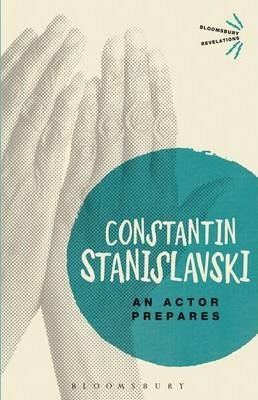

- "An Actor Prepares" by Constantin Stanislavski
- "The Sanford Meisner Approach" by Larry Silverberg
- "The Power of the Actor" by Ivana Chubbuck
- "The Actor's Art and Craft" by William Esper and Damon DiMarco
- "Respect for Acting" by Uta Hagen
- "Audition" by Michael Shurtleff
- "The Complete Stanislavsky Toolkit" by Bella Merlin
- "The Technique of Acting" by Stella Adler
- "A Practical Handbook for the Actor" by Melissa Bruder
- "Acting for the Camera" by Tony Barr.
" What makes a good model? Models they are a cross between an actress and a sportsperson. They have to have the physical stamina to endure literally hours of demanding work and they have to have the intelligence to understand and express the fashion narrative implied by the clothes that they are wearing. "
― Nick Knight
https://showstudio.com/projects/more_beautiful_women/interview_nick_knight
https://showstudio.com/projects/more_beautiful_wom...
Showstudio is a fashion media company based in London that was founded in 2000 by fashion photographer Nick Knight. The company is known for its innovative approach to fashion media, including its online platform that features interviews, articles, films, and live broadcasts that cover the latest developments in fashion, art, and culture. Showstudio is also recognized for its collaborations with some of the biggest names in the fashion industry, including designers, models, stylists, and photographers. Its mission is to push the boundaries of fashion media and challenge traditional ideas of what fashion can be.

In portrait or fashion photography, where expressions and body language are everything, music can help dissolve tension. A nervous model softens under the sway of a slow track, while an upbeat beat can lift the whole team, sparking spontaneity and laughter. Every genre, every tempo, tells a different story — and those stories weave their way into the images.
As a photographer, I’ve found music to be not just an emotional trigger but also a creative accelerator. It pushes me, sharpens my instincts, and sometimes leads me to shots I wouldn’t have imagined in silence. For the team, it creates flow — a shared rhythm that keeps everyone in sync and focused without even realizing it.
That’s why I treat music like I treat lighting: a tool that shapes the shoot. Choosing the right soundtrack can elevate the entire experience, turning work into play and images into something unforgettable.
types of lightning and how to use them
equipment
natural vs. strobes vs. continuous vs. led lights
my equipment

" I don't create a photograph, I find it. "
― Sante D'Orazio
" You don't take a photograph, you make it. "
― Ansel Adams

Every time I set up, it’s like starting from scratch. I don’t copy old formulas, I don’t repeat myself. I just look at the person in front of me and ask: What kind of light will make them come alive? One setup won’t work for everyone. Light has to fit the face, the mood, the body in front of you.
That’s why I believe in beginning simple. One light source. Master it. Twist it. See what moods you can create. Only then add more, if you really need it. But remember: technically perfect photography can also be the most boring thing in the world. Photography is just painting with light — and paint should never scare you.
I try to stay childlike on set. To play. To welcome accidents. To risk something that looks stupid at first. Because that’s when surprises happen. That’s when you stumble into your light — the one no manual can teach.
Don’t be afraid to build your own lamps, to tape a flashlight to a chair, to steal the lamp from your bedroom and turn it into a key light. It’s cheaper, more original, and often more fun. Every shoot, whether in a studio or on the street, is another chance to invent. Another chance to discover light all over again.
" Fashion photographers are the new painters. "
― Peter Lindbergh
then use ambient light and add a small key light on your subject
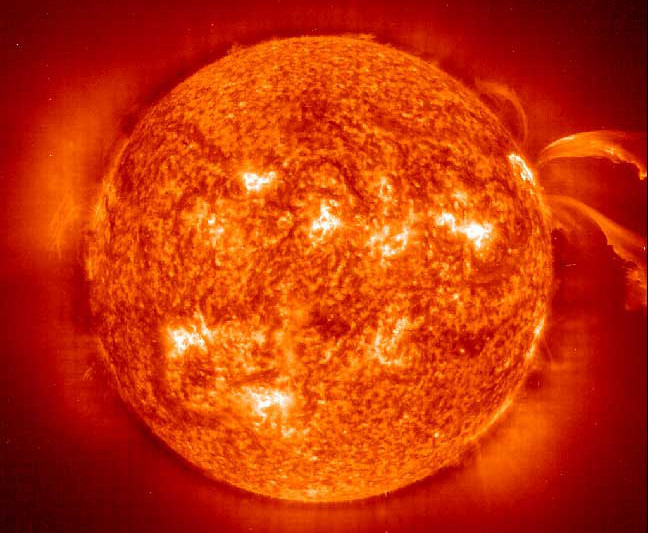
" The point is, you don't need 10 lights to make a great portrait. Heck, you don't even need one light. You can use the sun if you're clever! "
― Richard Avedon
" Most Avedon studio portraits were shot with a single key strobe light in an umbrella, with additional lights on the background. "
― Sebastian Kim


" Technically perfect photography may be the most boring picture in the world. "
― Unknown
Go online and search for lighting diagrams, setups, or tutorials — look for keywords like Rembrandt lighting diagram, butterfly lighting setup, split lighting, clamshell lighting, or even modern setups like eye-light patterns. Save at least 3–5 that catch your eye.
Step 2: Analyze
Look closely at each setup:
Where’s the key light placed?
What modifier is used (softbox, grid, umbrella, etc.)?
Are there fill lights, rim lights, backlights?
What’s happening with shadows and highlights?
What mood does the setup convey?
Step 3: Make It Yours
Recreate one setup in your studio or location using yourself as subject. Start simple. Use what you have — reflectors, existing lights, household items if necessary. Notice how even modest gear can produce the effect.
Step 4: Experiment Creatively
Once you’ve nailed the basic setup, twist it. Move the light, change modifiers, add a gel, adjust angle or distance — whatever expands the look. See what happens when you adapt it to your style.
Goal
By working through lighting schemes in real life, you build visual vocabulary and muscle memory. Over time, synthesizing these patterns with your instinct, you’ll create new lighting that feels uniquely yours.

" Allow for Serendipity: Move outside your normal realm of comfort and interest, explore far and wide, while staying open and avoiding jumping to conclusions. Let yourself be surprised and discover new opportunities. Keep a notebook with you at all time and record ideas as they appear to you. "
― Unknown

Pay attention to the light first. Look at how they build it. Where the strobes are placed. How they mix soft and hard light. Notice the modifiers, the reflectors, the gels. Watch how the photographer tests, tweaks, kills one source and adds another until it feels right. That’s how you learn to see light, not just use it.
Check the gear too. What cameras, what lenses, when they switch from one to the other. Don’t just note the brand — try to understand the decision. Why wide here? Why long lens there? What problem are they solving?
Then look at the human side. How the photographer talks to the team, how they keep control of the set without killing the vibe. Watch their body language with the model — are they giving direct instructions or letting her move freely? How does the model shift between poses? How much of it is instinct, how much comes from the photographer’s direction?
Backstage footage is like a secret manual. You see the whole machine at work: the lighting, the camera, the team, the mood. And when you start watching like that — not just for entertainment, but as training — you’ll catch yourself bringing those tricks onto your own set without even thinking.
For me, the biggest value is twofold: technical and creative. On the technical side, I pay close attention to the lighting schemes, the modifiers, the cameras and lenses. Watching how a photographer tests light, makes adjustments, or even improvises on set teaches me things I can later apply to my own work.
On the creative side, I’m fascinated by how photographers interact with their team. How do they give direction? How do they keep the atmosphere relaxed yet focused? How do they guide the models — not just posing, but movement, mood, energy? These are subtle skills you can’t always learn from textbooks but can sense immediately in a behind-the-scenes video.
For me, studying backstage videos isn’t just about keeping up with trends or copying techniques. It’s about sharpening my own instincts, finding inspiration in how others solve problems, and then translating that into my own language of photography. It’s become an essential part of my ongoing learning and growth.

* playback speed x2

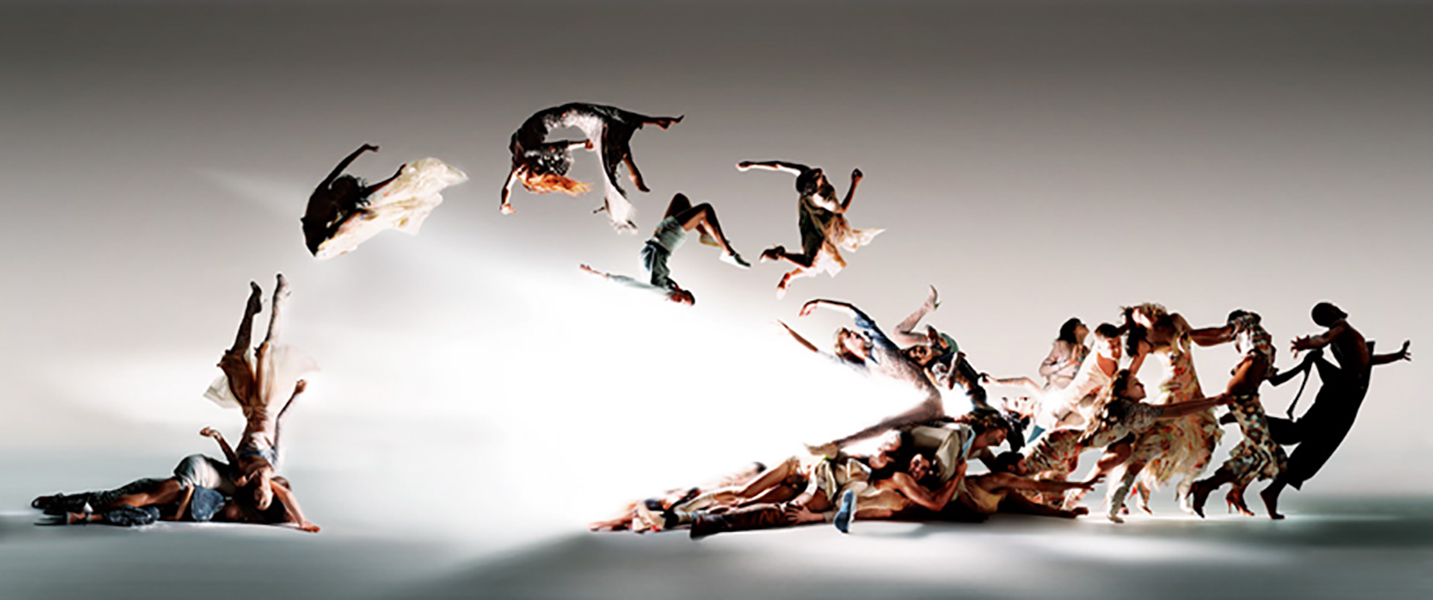
" You don't know how you're going to do it and you don't know how it's going to turn out. "
― Nick Knight
find the results below


- Look at how the space is set up — the background, the placement of lights, props, and equipment.
- Pay attention to details: where the light stands are positioned, how cables are arranged, what’s included in the frame and what’s deliberately kept out.
- Observe how the photographer and team move within that space. Notice how they compose the environment around the model to build the final shot.
Goal:
Train your eye to see not just the final image, but the architecture of how it’s built. This will help you understand how small choices in composition, placement, and detail shape the overall atmosphere of a shoot.






"It is naive to amuse yourself with the hope that mastery will come with experience" *
― Lidia Pavlovna Dyko
* ALSO RELATED TO EQUIPMENT
Most of the time I shoot with a Canon 5D Mark IV and three lenses: 135mm, 35mm, and 50mm. Recently, I added the Leica Q3 to my kit. It’s built around a 28mm lens, but with crop options at 28mm and 43mm, it gives me just enough flexibility while keeping things minimal. I like how intuitive it feels — simple, fast, and very direct.
For me, cameras are tools, not idols. They help me catch the moments I already see with my eyes. But if I spend too long hiding behind the viewfinder, I start to lose touch with reality. That’s why I often step back during shoots — to breathe, watch, and experience the moment without a camera. Those pauses reset my vision, and when I pick the camera up again, the images come out more alive and meaningful.
" I hate cameras. They interfere, they're always in the way. I wish I could just work with my eyes alone. "
― Richard Avedon
Intended for a wide audience.
1988
case studies
I used to create my photographs.
Sometimes I’ll blur it on purpose, push the grain, break the “rules.” The kind of images they tell you are wrong in photography school. But those mistakes have life in them. They shake you awake.
A clean, perfect shot can feel dead. Too polished. Too controlled. But when something unexpected happens — a blur, a streak of light, a rough edge — it feels more human. Like the picture is breathing.
That’s the trick: it looks like chaos, but it’s chosen. It’s not careless, it’s control disguised as chance.
So I do whatever it takes to create that space — a joke, a silence, a small detail that makes them forget the camera’s even there. That’s when the real face shows up.
Of course, the technical stuff matters too. Light, composition, posing — you can’t fake that. The wrong angle or bad lighting can kill a shot before it even starts. Same goes for clothes, makeup, hair. Every detail either helps or ruins the story you’re trying to tell.
But the best portraits? They’re not about perfection. They’re about catching that exact second when someone stops performing and just… exists.

We were shooting on the roof of ArtPlay. The weather was brutal — heavy wind, storm clouds rolling in. At some point, the wind hit her so hard her eyes started watering. She wasn’t crying, she wasn’t sad — just the wind tearing up her eyes.
I saw it and knew I had to shoot. The tears made the whole moment shift. Suddenly she looked mysterious, vulnerable, untouchable.
That’s the portrait I walked away with. Pure accident, pure truth.
" Think before and after shooting, but never in the process. "
― Unknown
This time the mood was nothing like before. The images came out darker, rawer, dripping with provocation and sexual tension. We started at Lobster Studio, playing with shadows and sharp angles, then moved to the Saint Room, letting the atmosphere shift with us. Each space gave a different charge, a different side of her.
It felt like watching someone shed an old skin and step into a new one — and I had the camera to prove it.





With just a single light, the body changes. Shadows fall harder, highlights cut deeper. Every curve, every muscle, every line becomes sharper, more alive. It’s dramatic, but also intimate — like the body is letting you in on a secret.
I love the control. I can push the light to graze across the skin, or slam it from the side and let half the frame drown in darkness. One light gives me space to experiment. No clutter, no overcomplication. Just me, the subject, and the way the light carves them out of the dark.
It’s my favorite way to capture the human form — stripped down, raw, and unapologetically sensual.




That kind of light is perfect for full-length portraits. It stretches the figure, elongates the muscles, gives you that balance of elegance and raw power. You don’t even have to over-direct — the daylight does half the work, sketching out a mood that feels honest, almost accidental.
What I love most is the tension it creates. There’s a softness in how the light caresses the skin, but also a sharpness in how it defines the form. It’s sensual without being staged. Beautiful without needing to shout.
That’s why I keep chasing it. Because sometimes, all you need is a window, a body, and the way the daylight decides to fall.
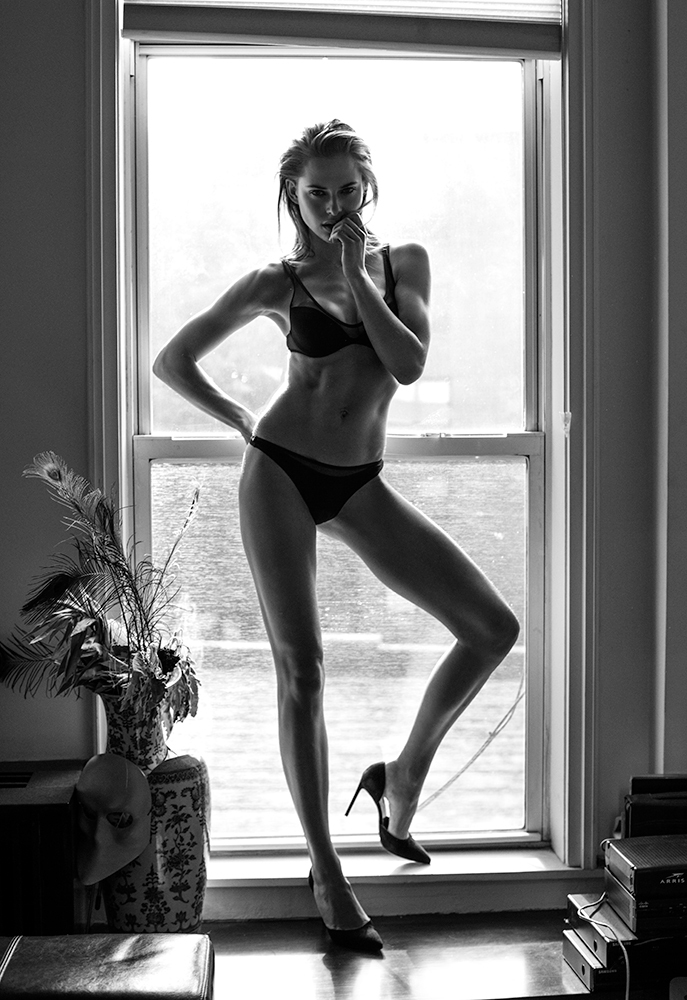
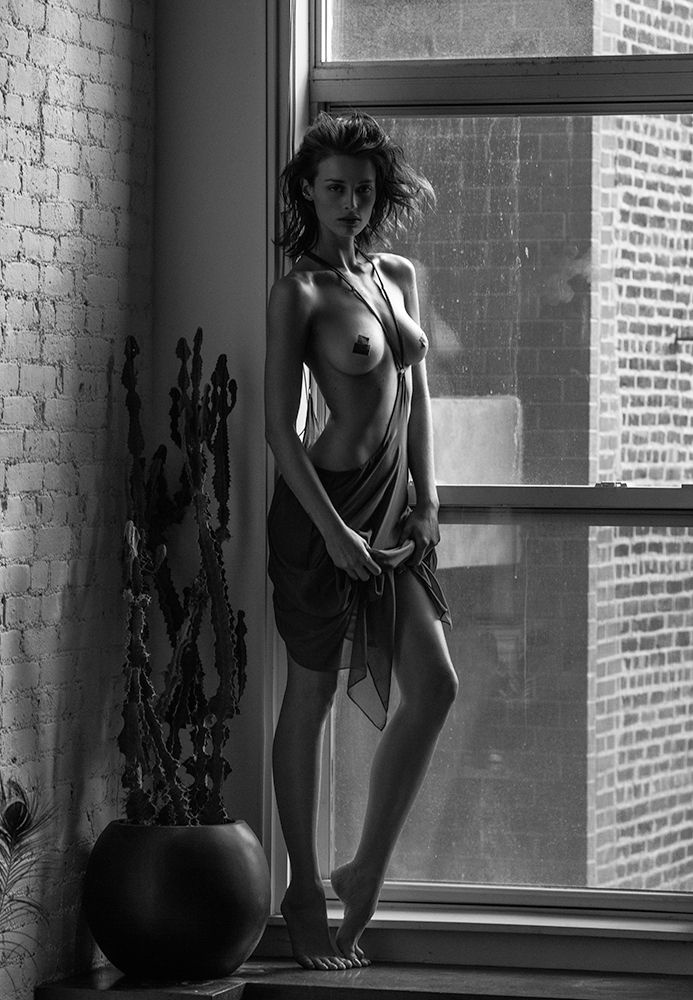

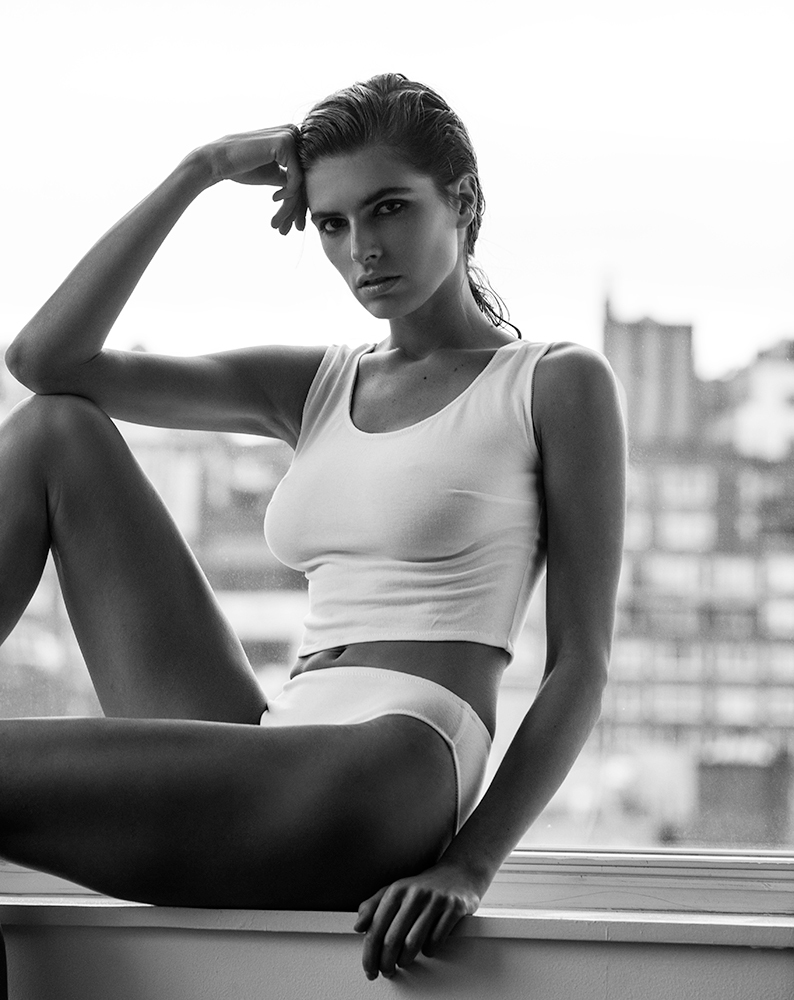
It’s like layering. The daylight gives softness, honesty. The strobe adds punch, edge, tension. When they mix, you get something that feels alive, not flat.
I also like to mess with the space itself. A chair, a mirror, some random object lying around — I’ll pull it into the frame just to break the geometry, to give the eye another path to follow. Suddenly the shot has more depth, more story, even if the object wasn’t “supposed” to be there.
That’s the fun of it. You start with light, you play with shape, and somewhere in between the photo starts breathing on its own.


That’s why the studio matters. It’s not glamorous, but it gives you control. You own the light. You decide how hard or soft it falls, what direction it comes from, what mood it creates. Nothing random, nothing accidental.
The consistency is another thing. Every frame can carry the same look, the same mood, no matter how long you’re there. That’s priceless if you’re building a series or need the shots to work together.
And then there’s privacy. In the studio, the world disappears. It’s just you and the subject, no strangers staring, no weather messing with you. People open up differently when they know nobody’s watching.
Comfort counts too. Air-conditioning, heat, water — it sounds boring, but it changes everything when a shoot lasts hours. Same with having the equipment right there — backdrops, strobes, props. You don’t waste time improvising.
The workflow flows smoother. No packing, unpacking, running across town. You move from one idea to the next without breaking rhythm.
And maybe the biggest thing — fewer distractions. Outside, the city never shuts up. In the studio, silence. You can hear the click of the shutter. You can hear someone breathe.
That’s the real beauty of it. A studio strips everything away until only the photograph is left.
"I feel alive when I take photographs. But my photographs always leave me feeling defeated. I am never able to put everything I know into them."
― Richard Avedon
But mirrors are my favorite. They do something wild. They bounce the light back in ways you don’t expect, cut the body into fragments, double it, distort it. You look through the lens and suddenly there’s more story in the picture — layers, echoes, a bit of mystery.
I like playing with the model in relation to the mirror. Sometimes I’ll have her face the glass so I catch her profile twice, once real and once reflected. Other times I’ll shift the angle so you only see a hand, an eye, something broken off from the body, like a secret.
It’s never perfect, but that’s the point. A mirror adds tension. It bends reality. It makes the image less about posing and more about discovery.
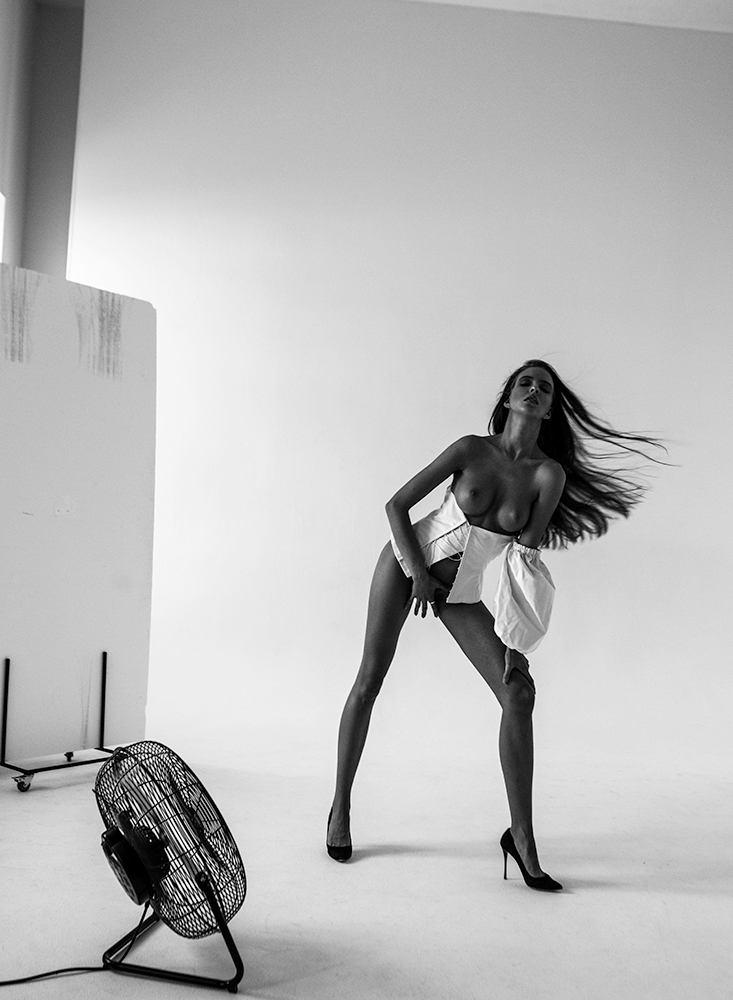

" I'm full of doubts still about the ability to get the picture I'm going to take.
"I'm a surprisingly limited photographer," he insisted to me, "and I've learned not to go beyond my capacity. I've tried a few times to depart from what I know I can do, and I've failed. I've tried to work outside the studio, but it introduces too many variables that I can't control. I'm really quite narrow, you know."
― Irving Penn
With a long exposure, the frame stops being frozen. The subject shifts, breathes, flickers. Sometimes it leaves a ghost behind, a blur wrapping around the body like smoke. Sometimes it’s just a streak of light, sharp against the darkness.
It doesn’t always work. Half the time it’s chaos — too much blur, too messy. But when it lands, it feels alive. Not staged, not polished. Just this raw movement trapped in the photograph, like you caught a secret in the room that wasn’t supposed to be seen.
That’s why I keep doing it. Because every once in a while, the accident looks better than the plan.


It changes the energy of the shot. A static pose turns into something cinematic, something that feels like a memory instead of just a frozen second. You can’t fully control it either — sometimes the fabric goes wild, sometimes it barely shifts, and both can surprise you.
That’s what I love about it. It’s unpredictable. It’s messy. And it gives you images that feel less like studio photos and more like something pulled out of a dream.
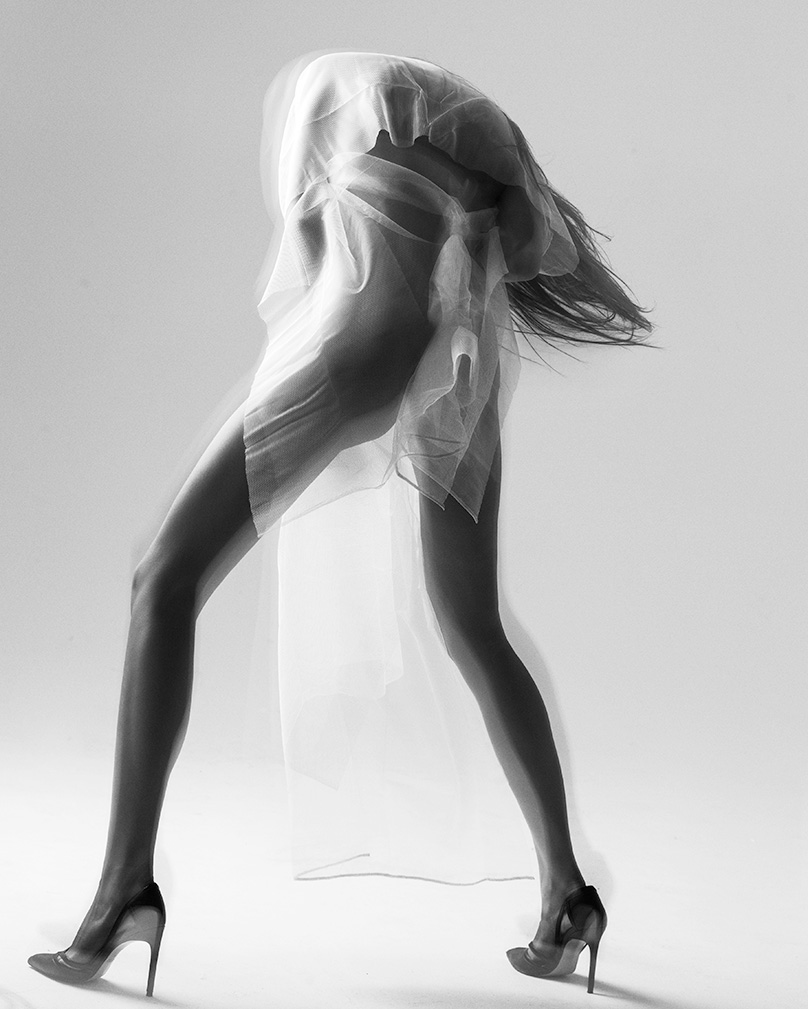



With the strobe, you can dial it from soft and inviting to sharp and almost violent. It’s not subtle, but that’s the point. It gives portraits and fashion shots this cinematic tension, like you’ve stepped into a scene instead of just a picture.
I like how it leaves an aftertaste. You don’t just see the image, you feel it — moody, dramatic, unforgettable.
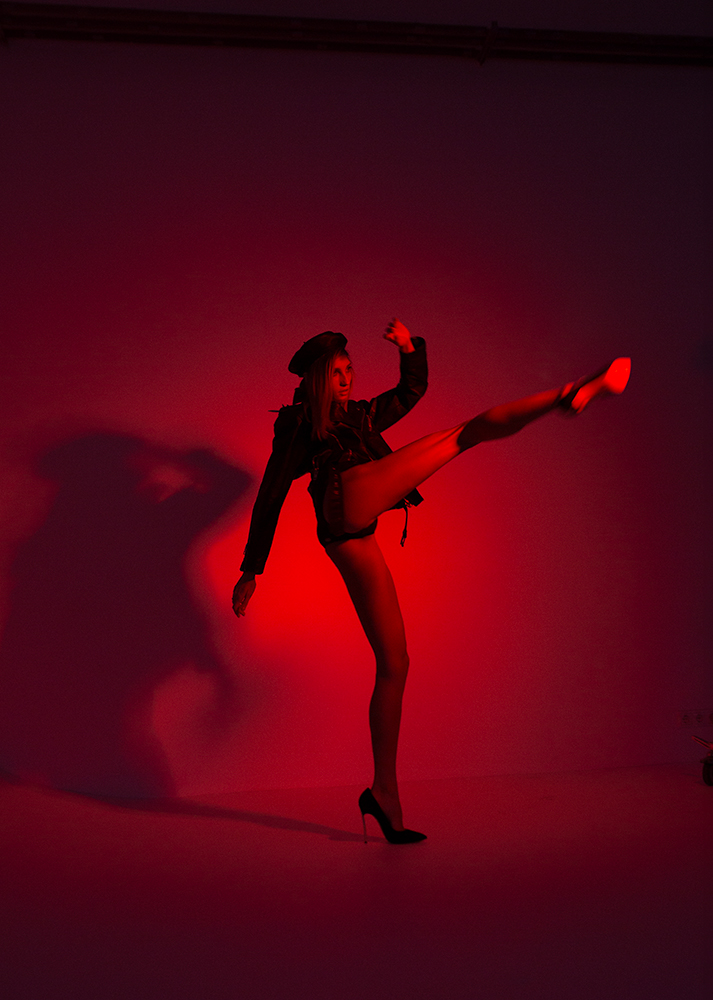

When I shoot, I try not to think of poses as “instructions” but as sparks. I’ll suggest something, show with my hands, but I want the model to make it their own. The best shots usually come in the in-between moments anyway — when they’re adjusting, laughing, slipping out of the “pose” into something real.
Angles are powerful. Twist a body, stretch an arm, bend a knee, and suddenly the frame feels alive. It’s not about making someone look perfect — it’s about finding the line, the shape, the posture that tells the story.
Communication is key. I talk, I guide, but I also listen. If a model feels awkward, it shows. If they feel free, it shows even more. The camera never lies about body language.
At the end of the day, posing isn’t just aesthetics. It’s energy. It’s how someone inhabits themselves in front of you. Get that right, and the photograph breathes.



If I slow down the shutter, the whole thing shifts. The flash freezes the person, but everything around them starts to blur, smear, move. It feels messy, like a memory half-erased. I love that.
In low light, the flash saves me too. It fills in just enough so you can see the face, the eyes, the little details that would otherwise vanish. Sometimes it’s not about making things pretty — it’s about making sure the expression doesn’t get lost in the dark.
The built-in flash is underrated. People think it’s amateur, but I like how unforgiving it is. It doesn’t flatter, it exposes. It turns a simple portrait into something bold, awkward, alive. And for me, that’s often better than “perfect.”

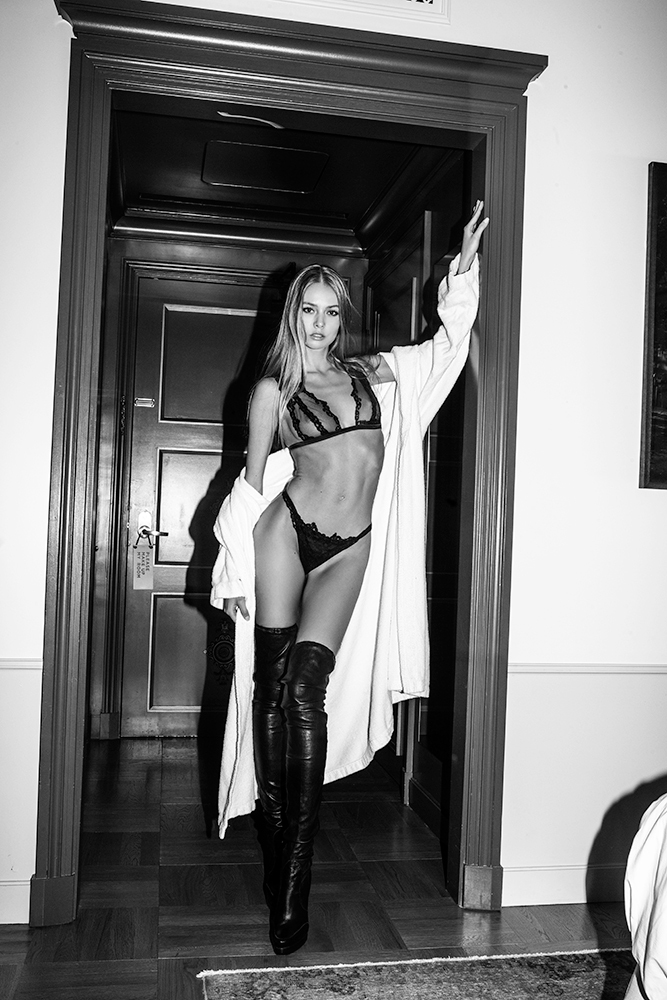
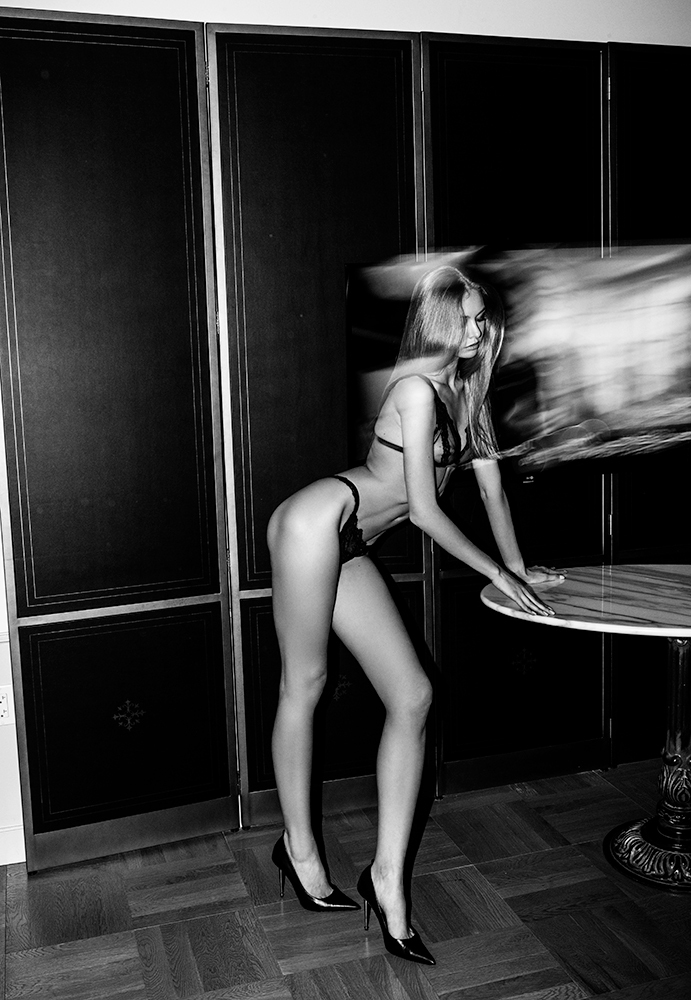
It’s not about piling on expensive looks. It’s about picking the one piece that nails the energy. The dress that says untouchable. The jacket that looks like it was stolen from a lover’s floor. The cigarette she doesn’t smoke but holds anyway.
That’s why I like working with stylists who get it. We sit down, spread out references, argue about fabrics and cuts until it feels right. Because once the model steps into the clothes, she’s not just herself anymore — she’s the story we’re about to tell.
And with Femme Fatale, that story is danger wrapped in beauty. Every detail, from the heels to the lipstick, is another piece of tension in the frame. You look at the picture and feel like she could ruin your life — and you’d probably let her.

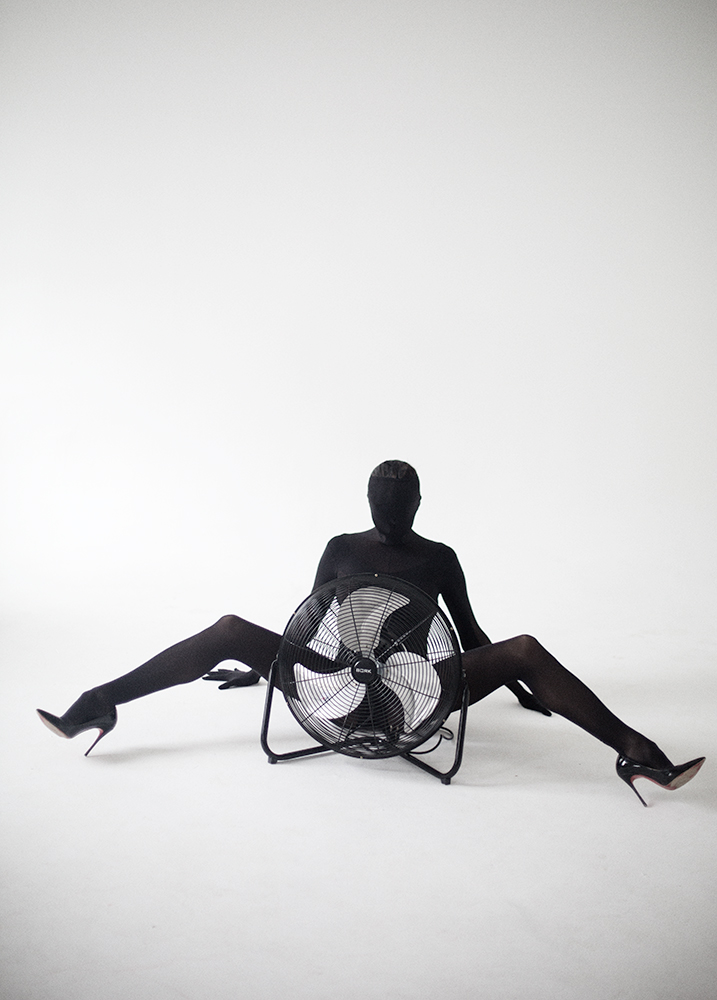
Sometimes I throw a red filter over it. Suddenly the room feels like a different world — moody, dramatic, a little dangerous. The light breaks into patterns and shapes across the body, and you don’t really know what you’ll get until you hit the shutter. That’s the fun part.
I’ve even projected actual images and textures onto my models — stripes, words, random visuals. The body becomes a canvas. Every frame feels alive, like the subject is wearing light itself.
Those are the moments where photography stops feeling like documentation and turns into something else — performance, painting, hallucination. A projector, some color, and a bit of risk is all it takes.

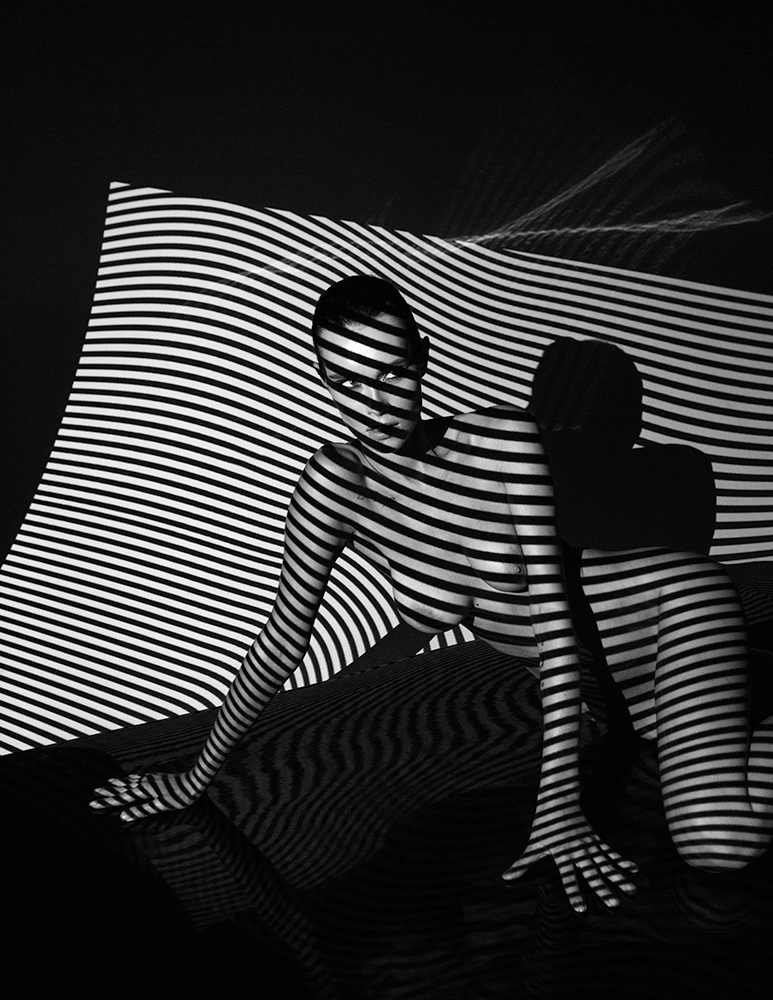





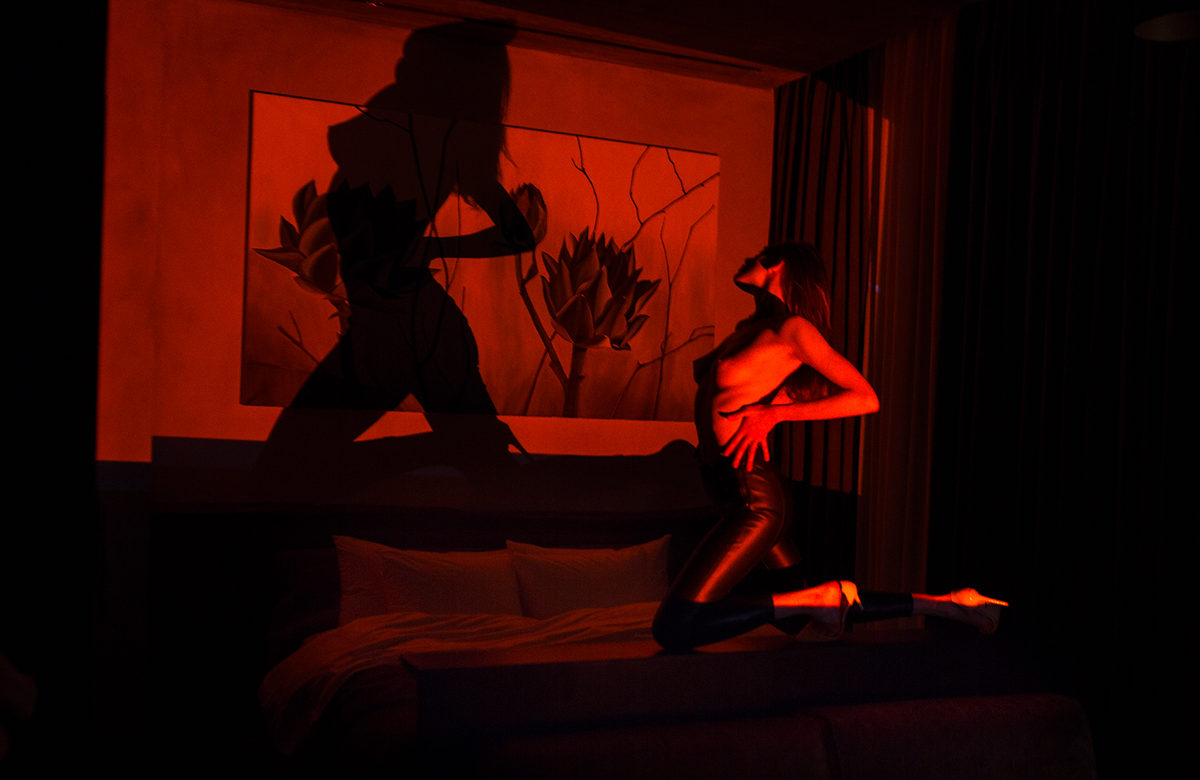
I’ve done shoots with projectors instead of studio lights. Grabbed random lamps from apartments. Threw colored gels over whatever light source I had. It’s not about having the “right” equipment — it’s about being willing to experiment until the frame feels alive.
That’s the fun part. Trying, failing, stumbling into something unexpected. Sometimes those accidents end up being the strongest images. The ones that don’t look like anyone else’s.
If you’re only chasing the polished, expensive setups, you’ll blend in. But when you start playing with scraps, with odd tricks and broken rules, that’s when your work starts to stand out.



" Letting the machine loose,
in taking risks, exploring the possibilities of film, paper, printing in different ways, playing with exposures, with composition and accidents.
It's all part of what an image can be, which is anything. Good pictures, bad pictures—why not? "
― Unknown
Experiment with using color filters in two different ways:
Holding in front of the lens
Place a colored gel or filter directly in front of your camera lens.
Notice how it shifts the entire scene’s mood and atmosphere.
Try layering two colors to see how they blend and affect skin tones, shadows, and highlights.
Fixing directly on strobes
Attach color gels to your strobe or flash head.
Compare how the light changes when it hits the subject versus when it washes over the entire space.
Play with angles — side light, backlight, or front light — and see how the mood changes.






Sometimes I’ll throw in colored gels. Blue, red, green — suddenly the whole mood shifts. You can turn a room from tender to violent with just one change in tone. It’s addictive once you start playing with it.
What I love most is how film lighting lets you move an image. Even if it’s still, it feels alive, like the subject is about to step forward or breathe differently. That’s the difference between a photo that just looks nice and a photo that hits you in the chest.




Now anyone can take a picture. Point, click, done. You can tweak it in an app, throw on a filter, and in two minutes it’s online. No need for a photographer, no waiting for edits, no middleman. You become your own photographer — self-portraits, friends, street corners, whatever.
We’re living in a golden age of photography. Millions of people shooting millions of images every second. But I can’t shake the feeling that this golden age is ending. Something else is taking its place — I call it contenography. Not photography for the sake of the image, but for the sake of content. For feeds. For clicks.
And here’s the thing — people trust their phones more than cameras now. They prefer the way they look on that little screen. The filters, the AI corrections — they’re like built-in Photoshop. They make you prettier, smoother, more polished. Even mirrors feel less honest than the phone camera.
That’s why iPhone shots get all the likes. They feel real, even if they’re not. Professional images are going somewhere else now — galleries, magazines, prints. The phone rules the internet. The camera rules what’s left of the art.



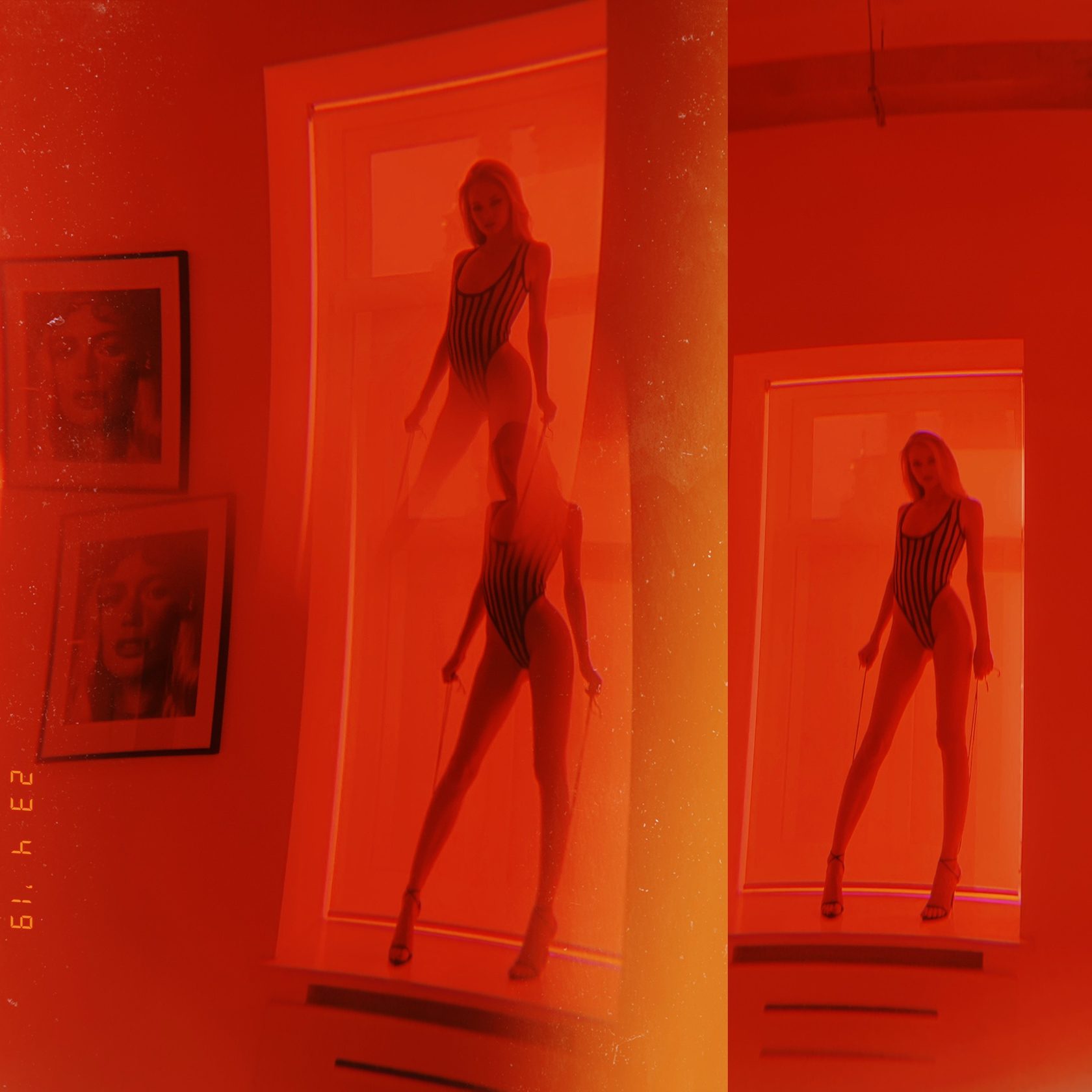
" If photographers are responsible for creating or reflecting an image of women in society, then, I must say, there is only one way for the future, and this is to define women as strong and independent. This should be the responsibility of photographers today: to free women, and finally everyone, from the terror of youth and perfection."
― Peter Lindbergh
the specifics of erotic photography
first experiments
erotic portraits
maintaining aesthetics


Back then, Paris fashion carried a different charge. It mixed art with eroticism. Even the old 70s porn look had been reabsorbed into the culture — in photography, in cinema, in album covers, in ads on the street. It was everywhere.
I leaned into it. Slowly at first. Letting clothes slip, playing with suggestion, seeing how far I could push without tipping into vulgarity. Those shoots opened me up. Made me realize the body could carry just as much narrative as a dress or a set.
Here are two photographs from that time — one shot in Moscow, the other in Paris. Both belong to that moment when I stopped resisting and let eroticism become part of my language.
For me, eroticism is in the face, not in the genitals. It's an old cliché to affirm that eroticism is the contrary of the total nude, and yet it is so true.
For me, a wealthy woman is more erotic than a beautician or a secretary.
A wealthy woman is naturally sexy.
My photos are stamped with vulgarity!
Creation comes from bad taste and vulgarity.
Voyeurism in photography is a necessary professional evil.
― Helmut Newton
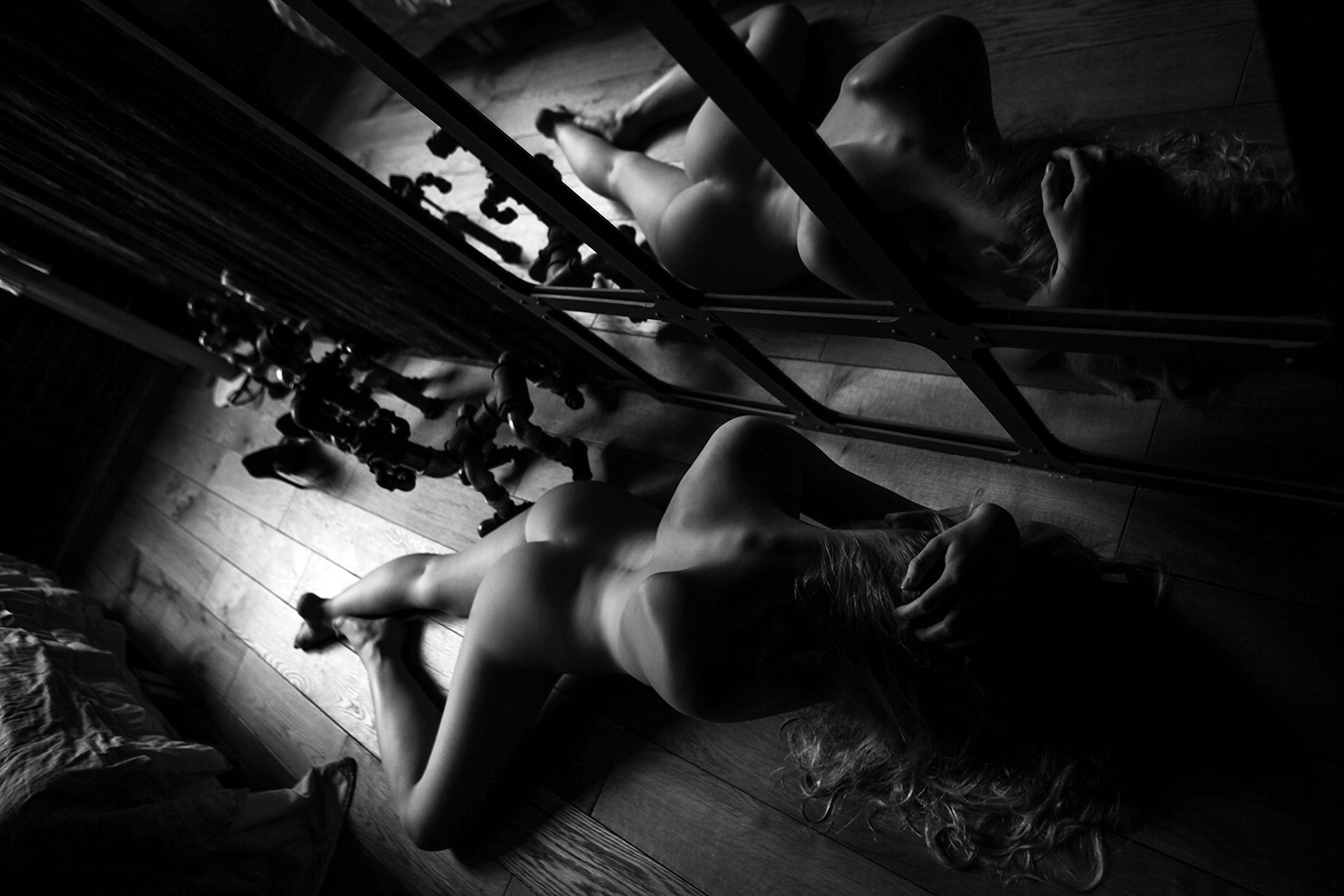

People love to argue about whether nude photography objectifies the subject. I don’t overthink it. I follow my instincts. If the image feels honest and beautiful, that’s enough for me.
At one point, I shifted almost completely from fashion to nudes. That wasn’t easy. Shooting someone naked is harder than it looks. Every detail shows. Skin texture, posture, the way the light lands. And on top of the technical part, there’s the human part: trust. If the model doesn’t feel safe, the photo dies.
That’s the weight of it. Nude photography isn’t just about beauty. It’s responsibility.
Generous, intelligent women with a sense of humour and the ability to make me laugh. Women with a strong character.
― Richard Avedon


For me, women are the center. Always. I don’t need men in the picture. I don’t need a couple. The tension, the seduction, the erotic charge — it’s all in her. How she looks at me. How she looks away. The body in the light, the suggestion in the movement.
I want the photograph to stand on its own, like a complete story. Not waiting for anyone else to arrive.
― Olivier Zahm









